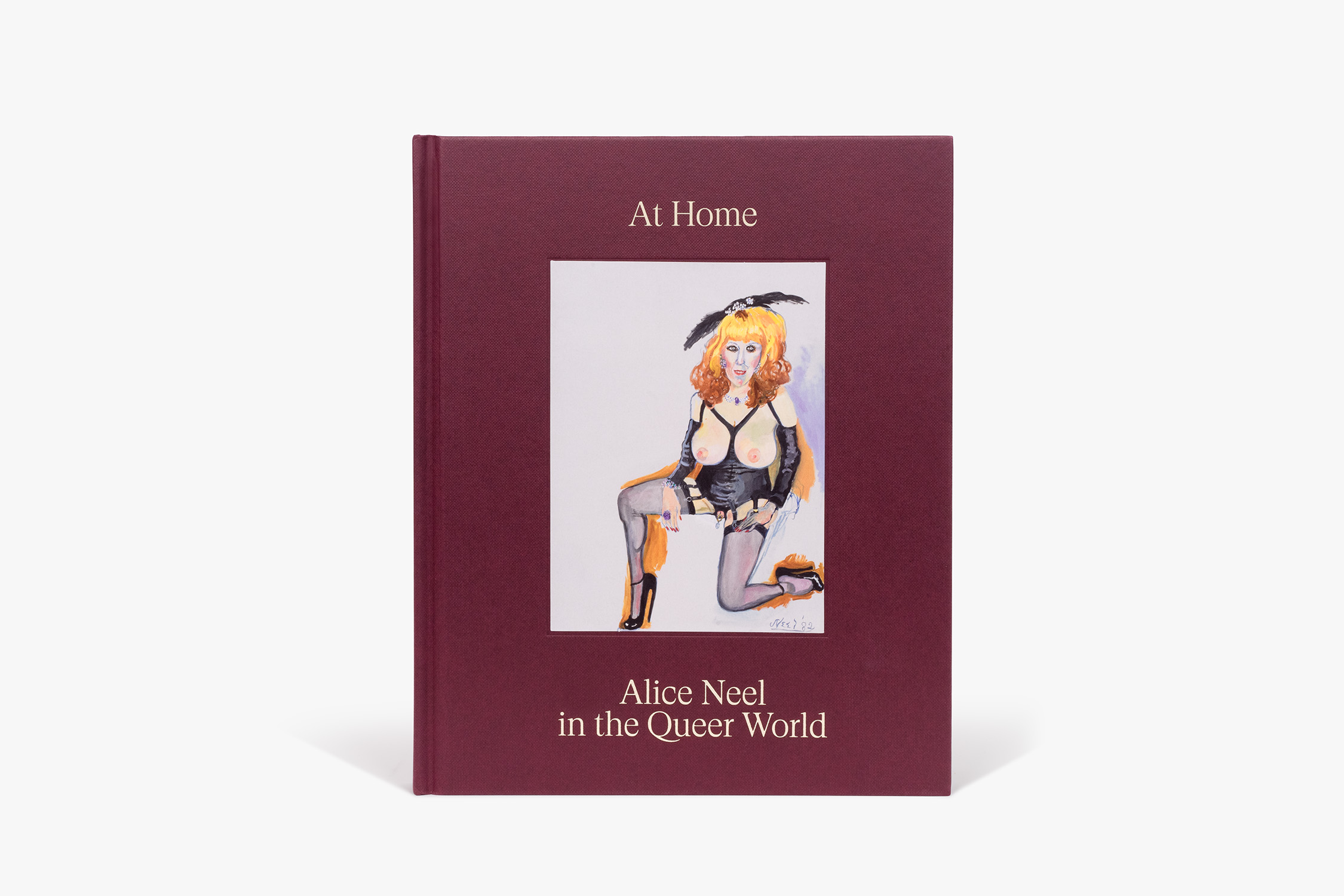Victoria Miro London
30 January–8 March 2025
Curated by Hilton Als, the gallery’s ninth solo exhibition of works by the celebrated American painter further extends an ongoing exploration of aspects of Alice Neel’s work and its continuing relevance today.
One of the foremost painters of the twentieth century, and among its most radical, Alice Neel (1900–1984) is known for her daring honesty in her pursuit of what she termed ‘the truth’ – of the individual and the broader society in which individual lives were lived. At Home: Alice Neel in the Queer World highlights the artist’s career-long commitment to depicting the human condition and her practice of painting people from many walks of life.
This exhibition focuses on her paintings of people from queer communities and those who were a part of their circle. The works on view include paintings of writers, performers and artists, as well as friends and neighbours – together forming a collective portrait that both embodies and complicates an understanding of the queer world of Neel’s moment and the artist’s place within it. As Als notes, this exhibition includes ‘not just portraits of gay people but those of theorists, activists, politicians, and so on who would qualify as queer by virtue of their different take in their given field and thus the world. So doing, they reflect Alice’s own interest in and commitment to difference.’
Highlights include paintings of figures such as Frank O’Hara (one of two paintings of the poet and curator completed by Neel in 1960); the provocative Beat poet Allen Ginsberg, whom she painted from memory in 1966 after seeing him at a performance; performance artist and sexual icon Annie Sprinkle (1982); and Andy Warhol in a drawing (c.1970) inscribed to performers Jackie Curtis and Ritta Redd – further reflecting Neel’s interest in various creative and avant-garde communities.
Also on view is related archival material that illuminates the lives and accomplishments of the individuals depicted by Neel and their surrounding historical and cultural contexts. These subjects, united here through a connecting thread of difference, demonstrate the breadth of Neel’s work and the unfettered scope of her humanist vision.
The first iteration of this exhibition, also curated by Als, took place at David Zwirner, Los Angeles, 7 September–2 November 2024. The exhibition is accompanied by an expansive catalogue, published by David Zwirner Books. Edited and with a text by Als, the volume includes newly commissioned scholarship on the artist by Alex Fialho, Evan Garza, and Wayne Koestenbaum.
‘When she died in 1984, Neel had a great number of masterpieces to her credit, a galaxy of masterpieces, I would say, that bear witness to the terror we usually turn away from, having no language for it, namely alienation, disconnect, love.’ — Hilton Als, from the accompanying publication
Annie Sprinkle, 1982
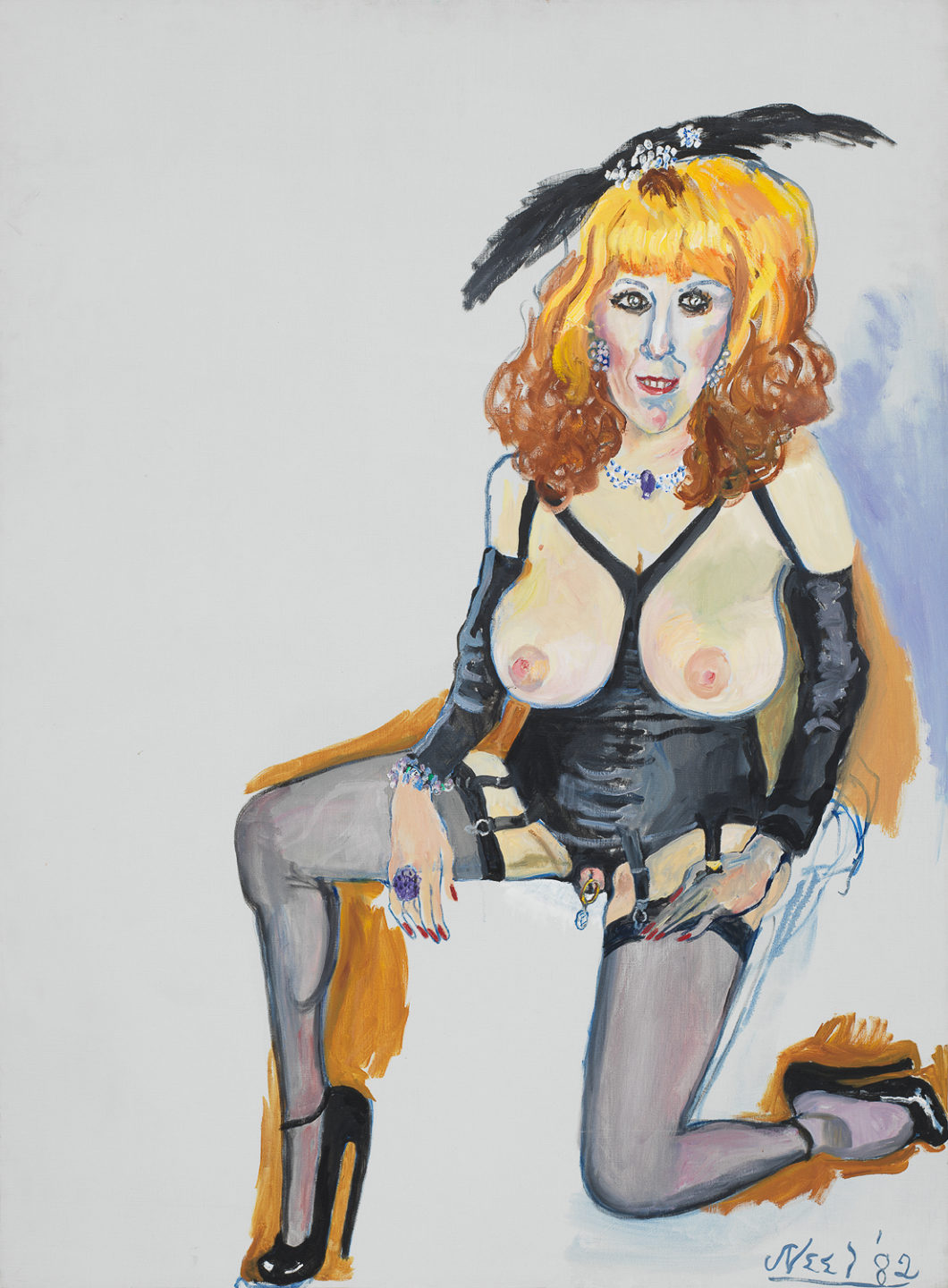
Oil on canvas
154.6 x 112.1 cm
60 7/8 x 44 1/8 in
Alice Neel, Annie Sprinkle, 1982
More info‘This provocative late-career portrait – one of the artist’s last before her death – is perhaps her most revealing for its remarkable restraint… This is a picture of a woman seeing, studying, and capturing the power of another woman – provocateur to provocateur. In that sense, the work is also a kind of self-portrait, a conduit for their shared and respective strength, both as artists and as women.’
— Evan Garza, from the accompanying publication
Annie Sprinkle (b. 1954) is a feminist performance artist, sex educator, advocate for sex work and healthcare, and a former sex worker. Sprinkle met Neel through the artist’s framer and mutual friend, Dennis Florio (who had been painted by Neel four years earlier). Sprinkle recently recalled her experience sitting for the artist, and the painting that came to be: ‘It’s really nice to be seen and studied. It’s erotic, frankly, to be seen. It was a sexy experience. Creativity and sexuality are very linked, as queers know pretty well…. I had that leather outfit made, and the bust was totally cut out and the crotch. I brought a suitcase full of stuff for Alice to pick from, and she picked that. I had my labia pierced right around then, and I showed it to her. I wasn’t shy. She seemed very queer to me – her curiosity.’
‘It’s erotic, frankly, to be seen. It was a sexy experience. Creativity and sexuality are very linked, as queers know pretty well…’ — Annie Sprinkle
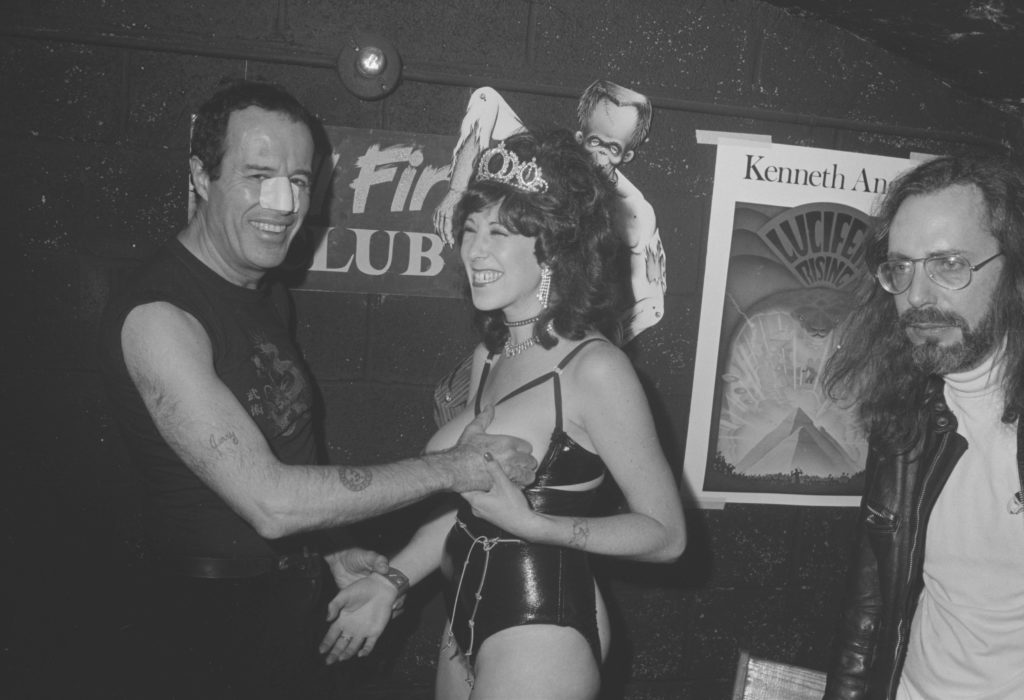
Dennis Florio, 1978
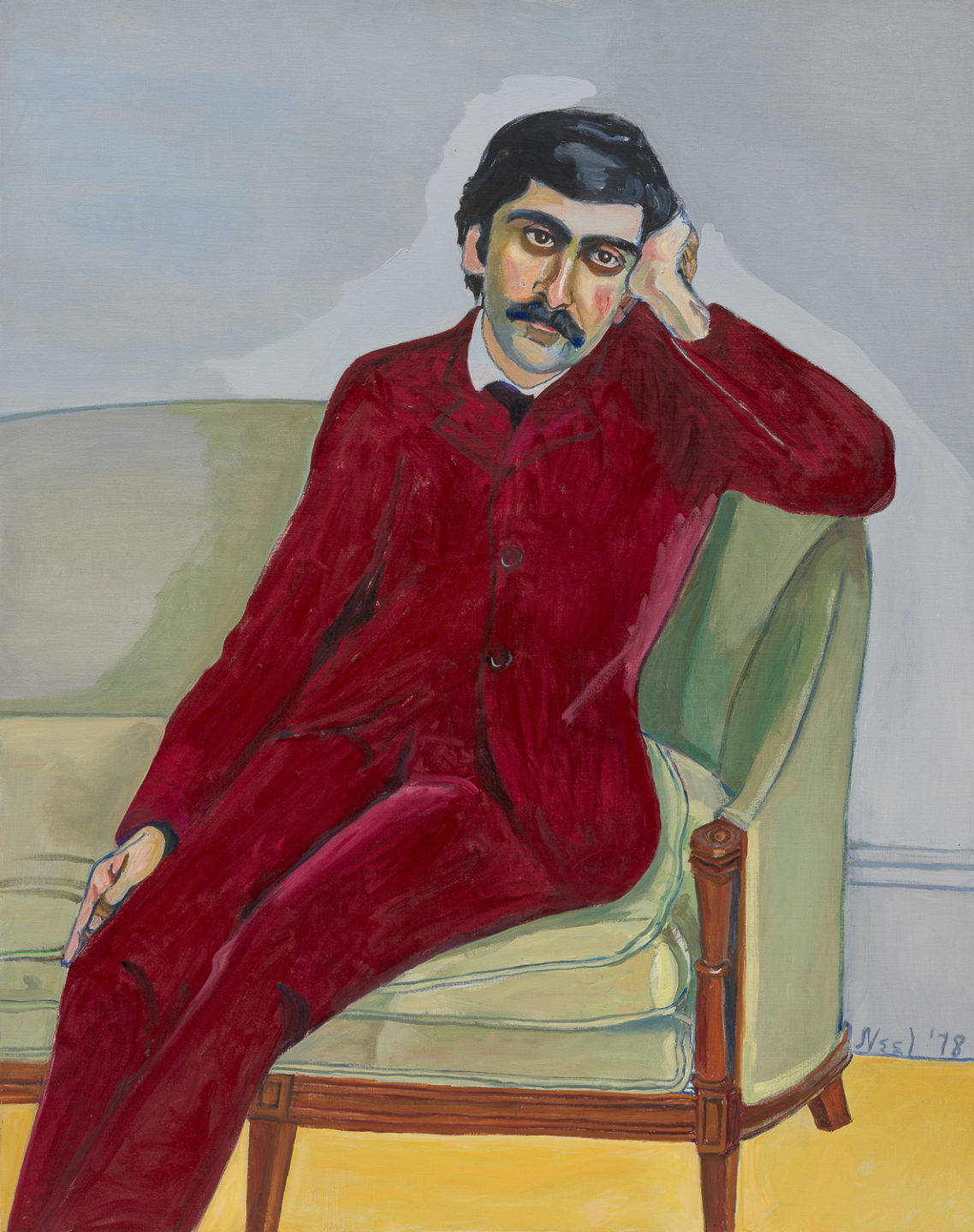
Oil on canvas
121.9 x 96.5 cm
48 x 38 in
Alice Neel, Dennis Florio, 1978
More info‘In Neel’s rendering of Dennis Florio, with handlebar moustache and red velvet suit, he looks like Proust, eyes burning their durée into us.’
— Wayne Koestenbaum, from the accompanying publication
In 1978, Neel painted Dennis Florio (c.1951–1988), a fine-art framer with whom she shared a mutual friend, the performer Annie Sprinkle. In her 2008 book A Short Life of Trouble: Forty Years in the New York Art World, art historian Marcia Tucker describes him: ‘Dennis Florio, whom I’d first met because he was a framer for the Whitney, lived his entire life as though he were onstage. He was a loyal member of the Theme Luncheon of the Month Club, an extrovert, a rake, and an outrageous wit. It took a while for his friends to realise that he was suffering from AIDS-related dementia, because causing a scene was something he did regularly, just for fun. Only when the police had to carry him out of his apartment and lock him up for disturbing the peace did we know that something was seriously wrong. His mind was clear, though, when with his last breath he whispered to the crying friends gathered around his bed, “Whatever you do, make sure I’m cremated. Nothing can get me to go back to New Jersey!”.’ Florio and Neel were close, and he travelled with Neel and her family to Russia in 1981 on the occasion of her solo exhibition at the Moscow Artists’ Union. In this work, Neel paints Florio in a pose that echoes that of nineteenth-century French writer and critic Marcel Proust, as captured in a famous c.1896 photograph. Neel explained of this sitting, ‘I hate plagiarism and I never let anything influence me. I put him in the pose of Proust but the rest is pure Florio.’
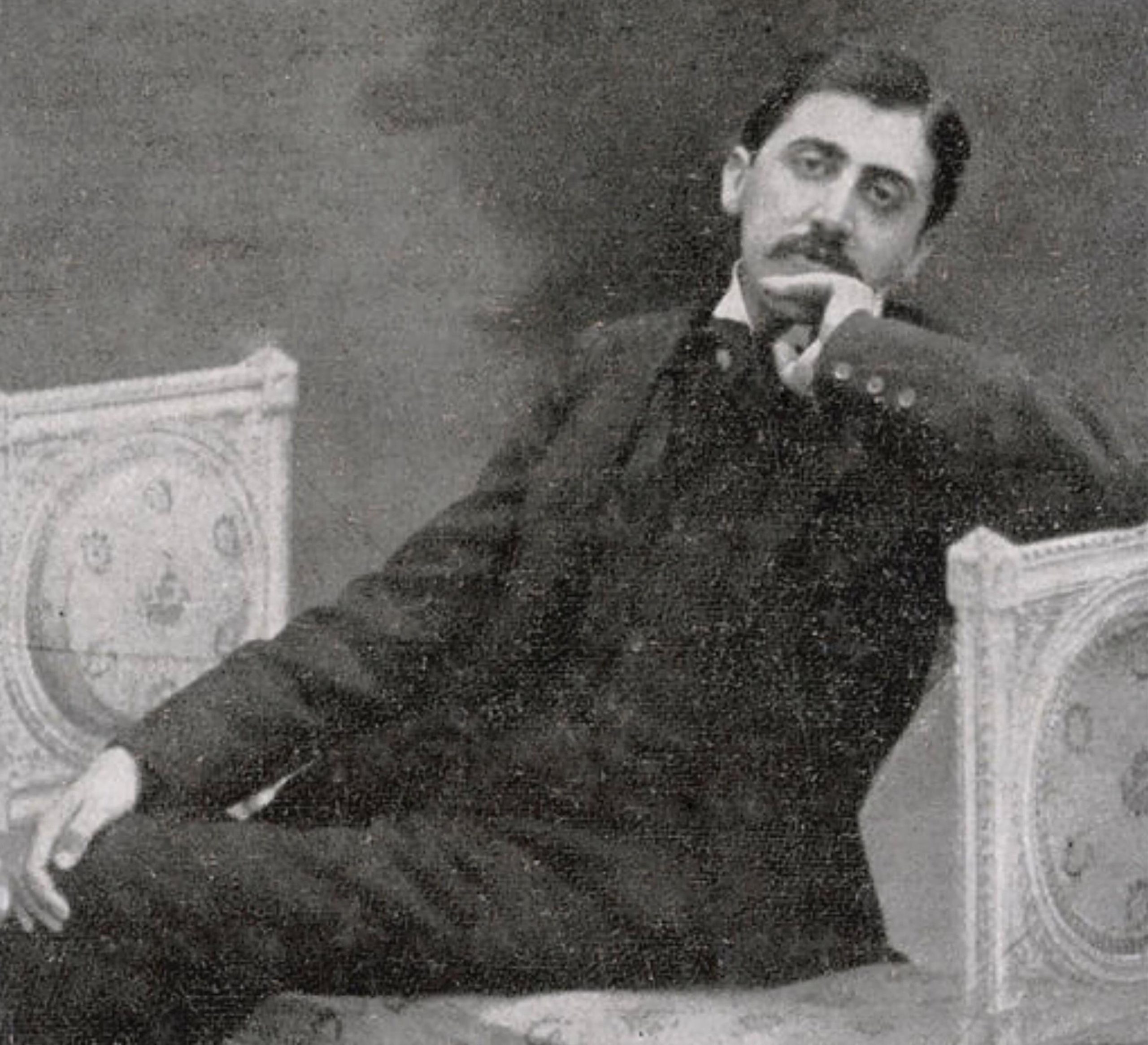
Andy Warhol, 1970
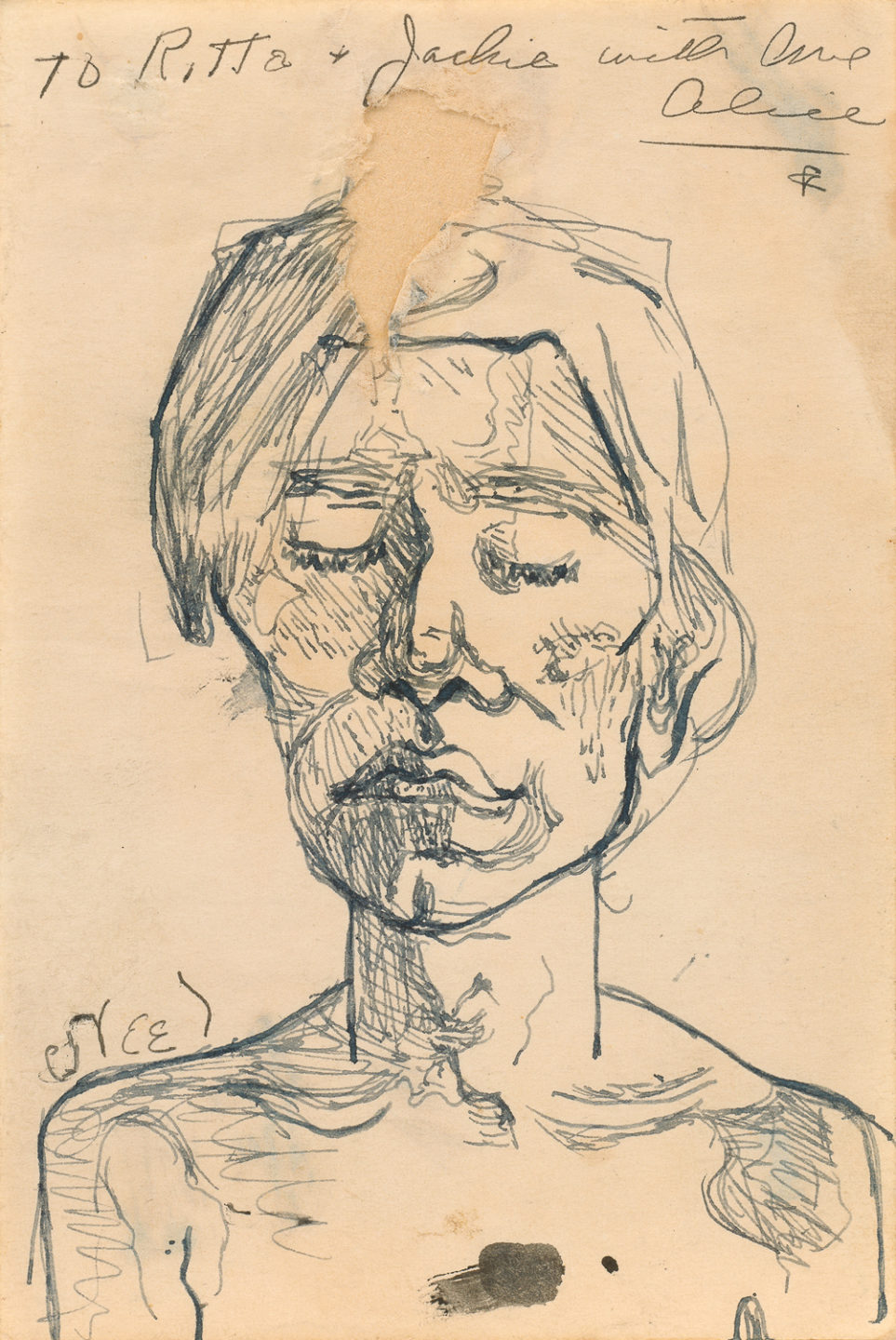
Ink on paper
6 x 4 inches
15.2 x 10.2 cm
Alice Neel, Andy Warhol, 1970
More infoThis drawing of Andy Warhol (1928–1987) relates to Neel’s well-known painting of Warhol from 1970, which is widely regarded as one of the artist’s most significant paintings (and is in the collection of Whitney Museum of American Art, New York). Neel inscribed the present drawing to performers Jackie Curtis (a Warhol ‘superstar’) and Ritta Redd, whom she painted together, also in 1970. Neel recalled, ‘Andy Warhol posed for me. And then after he posed, he sent me Jackie Curtis and Ritta Redd.’
Allen Ginsberg, 1966
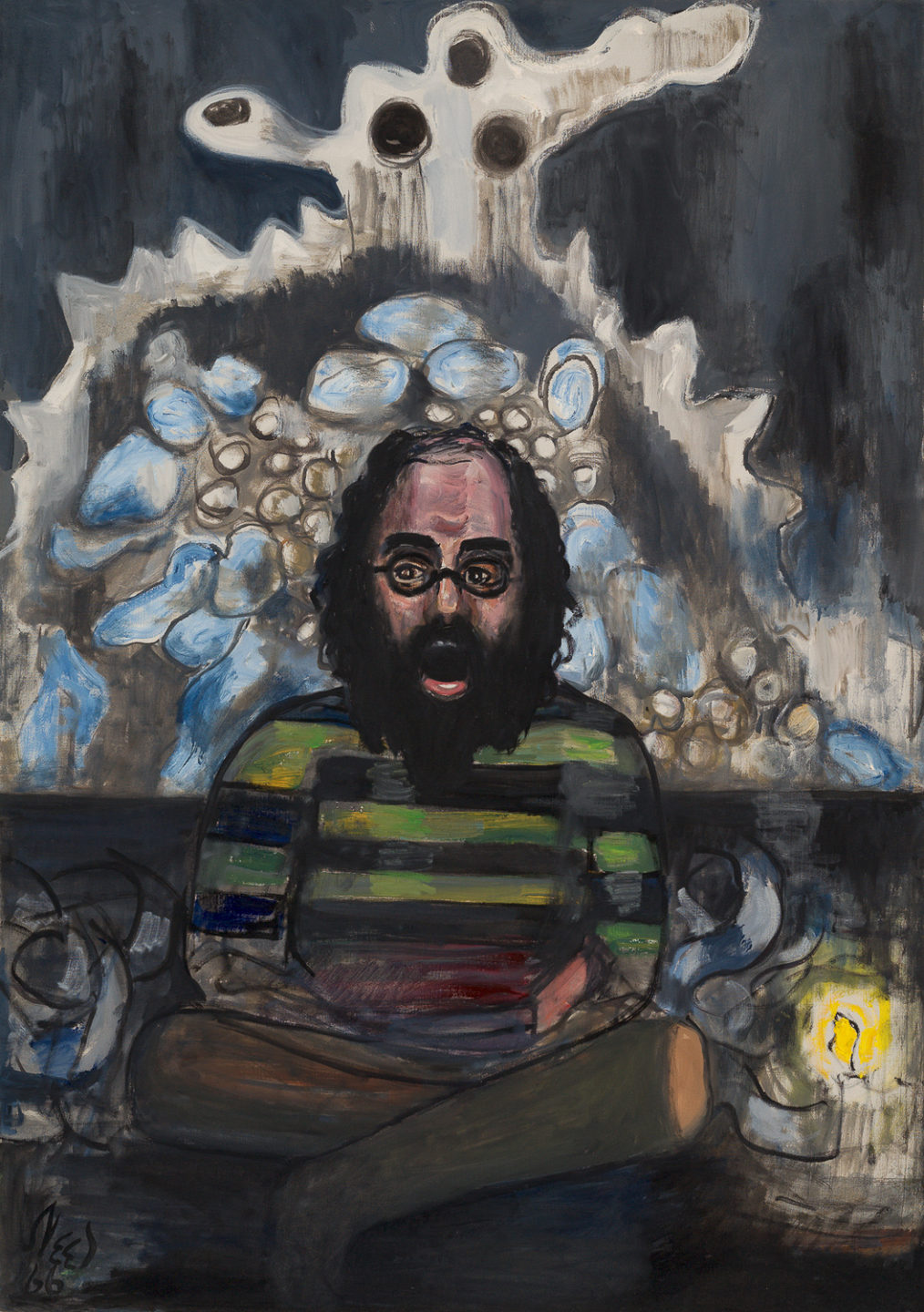
Oil on canvas
50 x 35 1/4in
127 x 89.5cm
Alice Neel, Allen Ginsberg, 1966
More info‘I looked like a conventional American type. I had a hat then, and orange gloves and an orange scarf. I went [to the first day of shooting] and there was Allen Ginsberg. So I said, “Oh, are you taking the part of Allen Ginsberg?” And he said, “No I am Allen Ginsberg.”.’ — Alice Neel on her experience filming Pull My Daisy with Allen Ginsberg in 1959
Neel met the celebrated American writer and Beat poet Allen Ginsberg (1926–1997) in 1959 on the set of Robert Frank and Alfred Leslie’s film Pull My Daisy, in which they both appeared alongside other Beat poets and artists. In this work (painted by Neel from memory after seeing Ginsberg perform with Dr. Timothy Leary in 1966) the poet sits cross-legged next to a glowing candle, his torso and open-mouthed face surrounded by abstract, orb-like forms. The composition mimics the gritty, improvisational, and often frenetic style of poetry that Ginsberg and the Beats were known for, and speaks to the hallucinatory quality of their performances at the time.
A leading member of the Beat generation of writers who emerged around 1944 out of Columbia University, Ginsberg moved to San Francisco in the 1950s and, in 1956, published his best-known poem, Howl, to both great acclaim and controversy; in 1957 there was an obscenity trial against the poem due to its content, much of which was based on Ginsberg’s relationship with the poet Peter Orlovsky (1933–2010). In his work, Ginsberg wrote openly about his identity and gay desire, in effect challenging the obscenity laws of the time and paving the way for younger LGBTQ+ artists and writers to express themselves freely. Ginsberg read a poem at the memorial service held for Neel after her death in 1984 at the Whitney Museum of American Art.
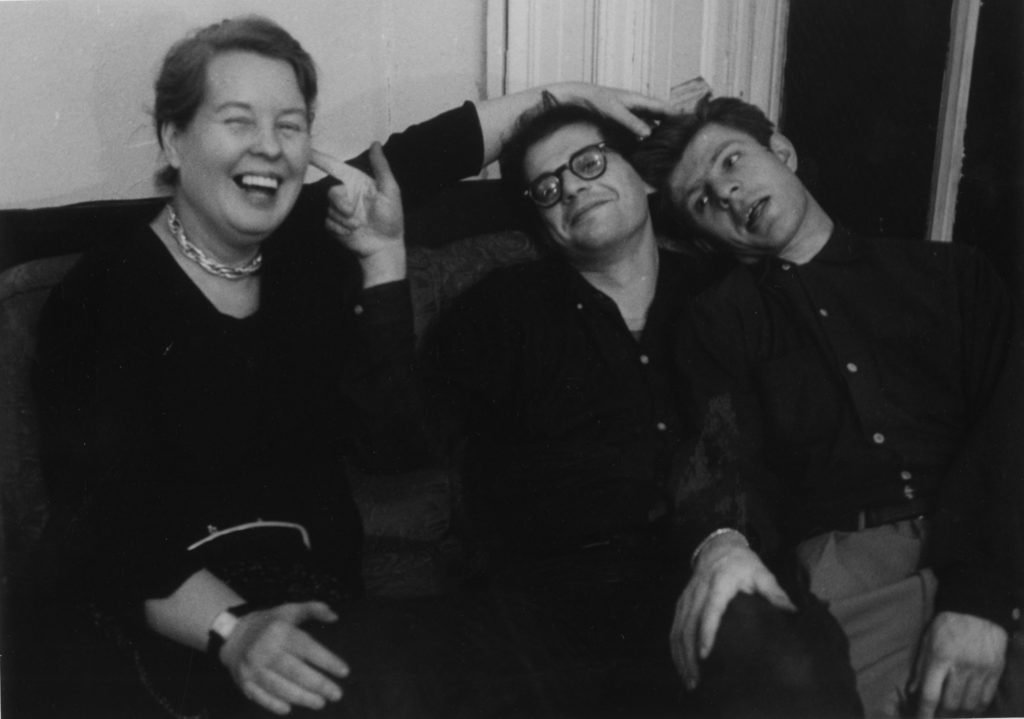
Frank O’Hara, No. 2, 1960
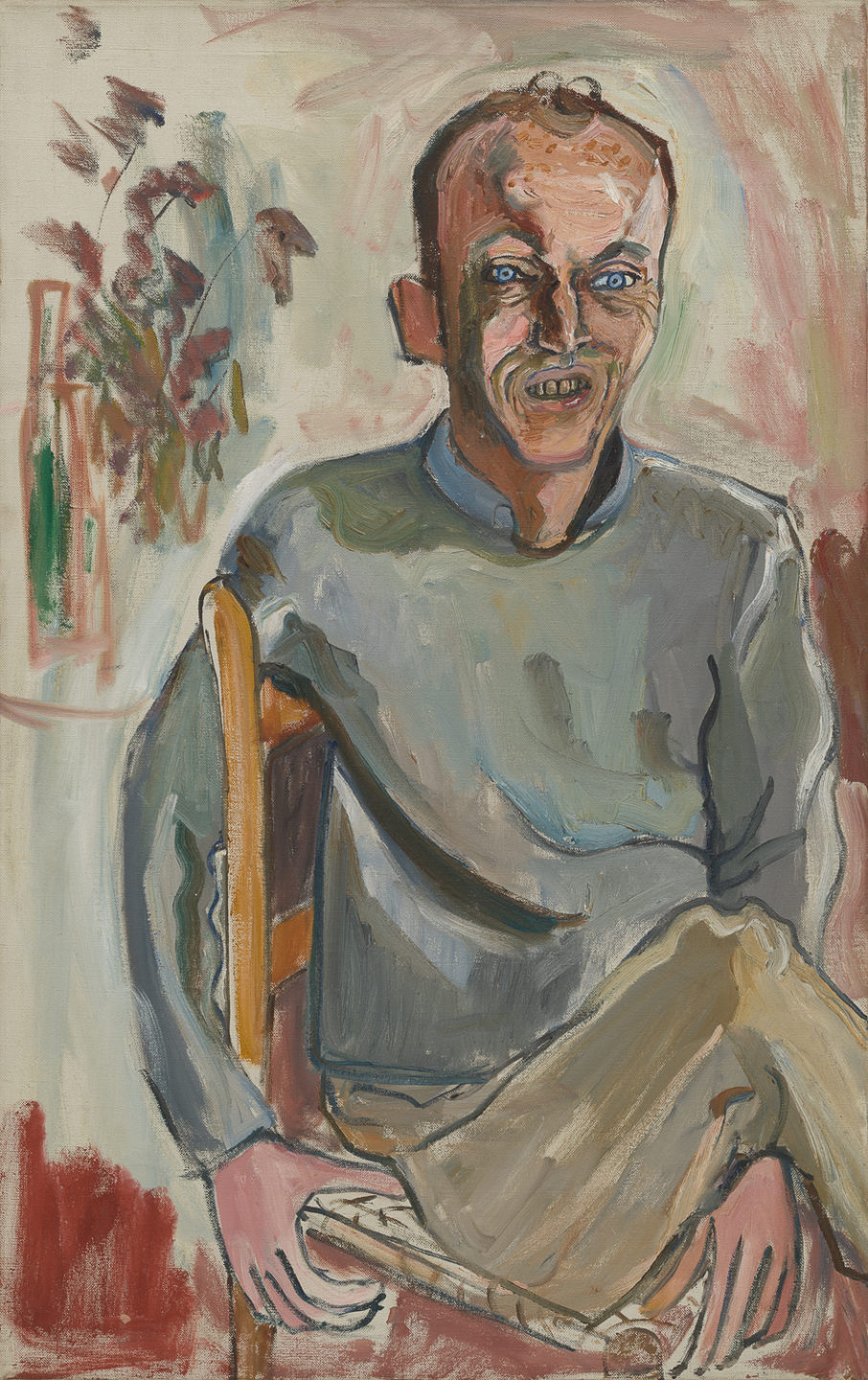
Oil on canvas
38 x 24 in
96.5 x 61 cm
Alice Neel, Frank O’Hara, No. 2, 1960
More info‘Frank O’Hara, No. 2, showing O’Hara smiling through teeth that the painter later compared to “tombstones”, is one of Neel’s masterpieces, and one of the great works of American figurative painting.’
—J. S. Marcus, The Wall Street Journal, 2008
Frank O’Hara (1926–1966) was a prolific poet, as well as a curator at The Museum of Modern Art, New York, at the time of his sitting. By 1960, he had published several collections including Meditations in an Emergency (1957), Second Avenue and Odes (both 1960), and that year his poetry was brought to wider public attention when it was included in Donald Allen’s seminal anthology The New American Poetry: 1945–1960. Neel met O’Hara at a meeting of the Abstract Artists Club in the 1950s. This is one of two paintings of him that she completed in 1960; the other, which shows O’Hara in profile, is in the collection of the National Portrait Gallery, Washington, DC. Neel recalled, ‘In 1959, I called Frank O’Hara and asked him to pose for me. First I did a romantic falconlike profile with a bunch of lilacs in the painting. When he came for the fifth time I really had finished the profile; so I asked him if I could do another one…. I started with the mouth. His teeth looked like tombstones; the lilacs had withered. When he saw the picture he said: “My God! Those freckles! But the Fauves went that far.”.’
Brian Buczak, 1983
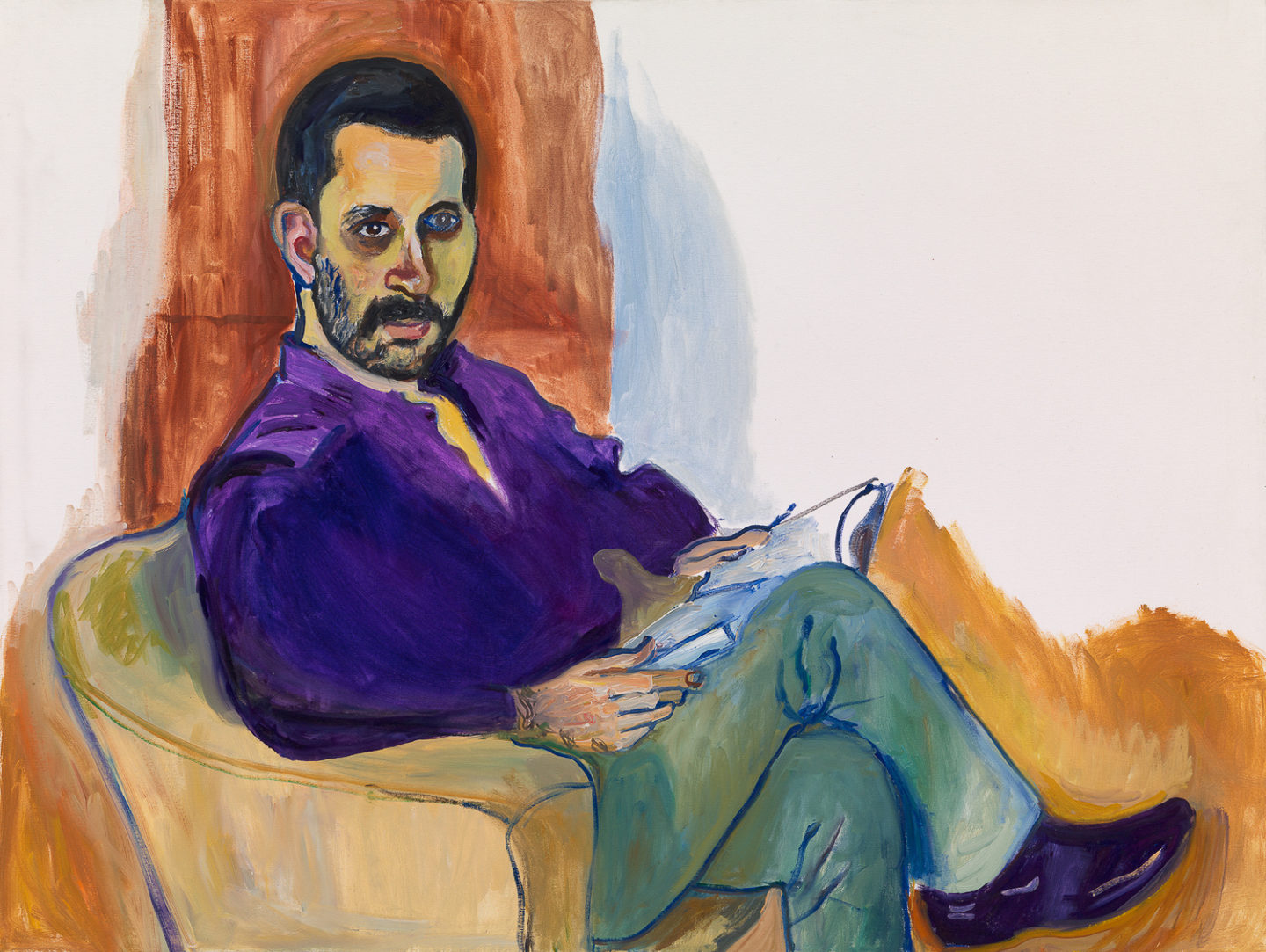
Oil on canvas
36 x 48 inches
91.4 x 121.9 cm
Alice Neel, Brian Buczak, 1983
More infoBrian Buczak (1954–1987) was a multidisciplinary artist whose short yet expansive and collaborative career encompassed painting, writing, performance, publishing, Fluxus projects and more. He was the partner of Fluxus artist Geoffrey Hendricks (1931–2018). Buczak and Hendricks met Neel in the autumn of 1977 at Rutgers University in New Jersey, where Hendricks taught at the time, following a slide lecture Neel delivered on campus. Buczak and Neel maintained a friendship over the following years, with the younger artist occasionally returning to Neel’s apartment for visits. He and Hendricks also corresponded with Neel by mail, sending casual notes of affection. Buczak joined Neel to celebrate her eightieth birthday in 1980. In 1986, he was diagnosed with AIDS. He died in 1987 at the age of thirty-two. Hendricks organised a posthumous exhibition in Buczak’s honour in 1989 and commissioned composer Philip Glass to write a memorial piece, String Quartet No. 4.
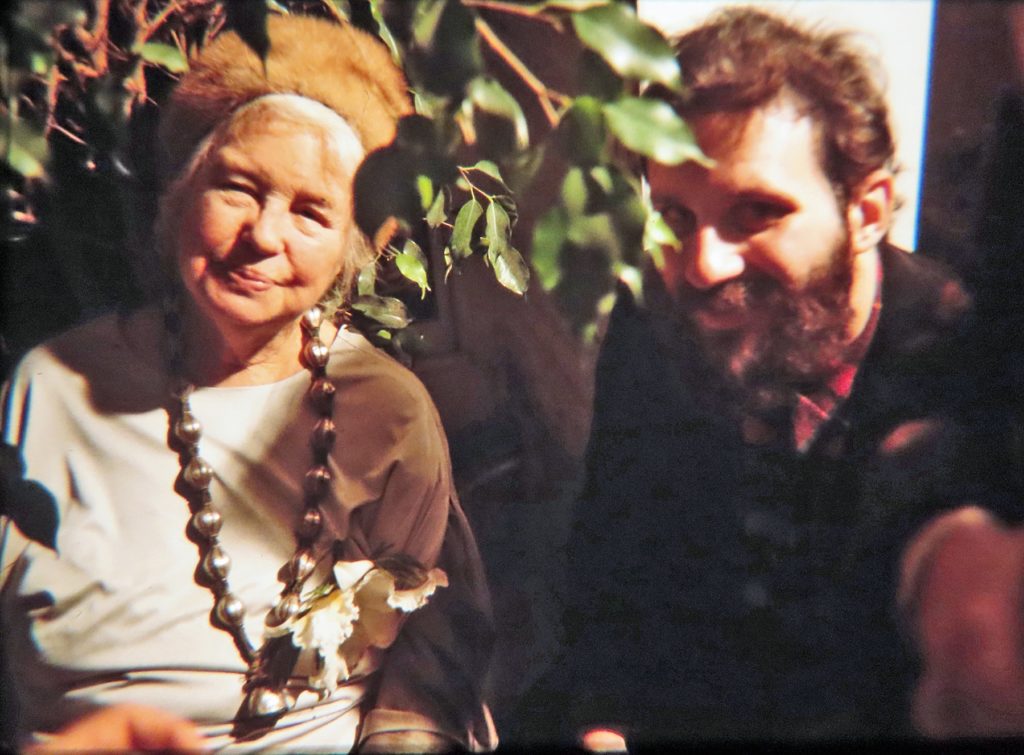
‘[Neel] seemed to be saying in canvas after canvas that there was no word or image that could equal those fleeting moments of joy – of connectedness – that bound her not only to her subjects, but to painting itself, that solitary act that she performed in front of other people.’ — Hilton Als
Ballet Dancer, 1950
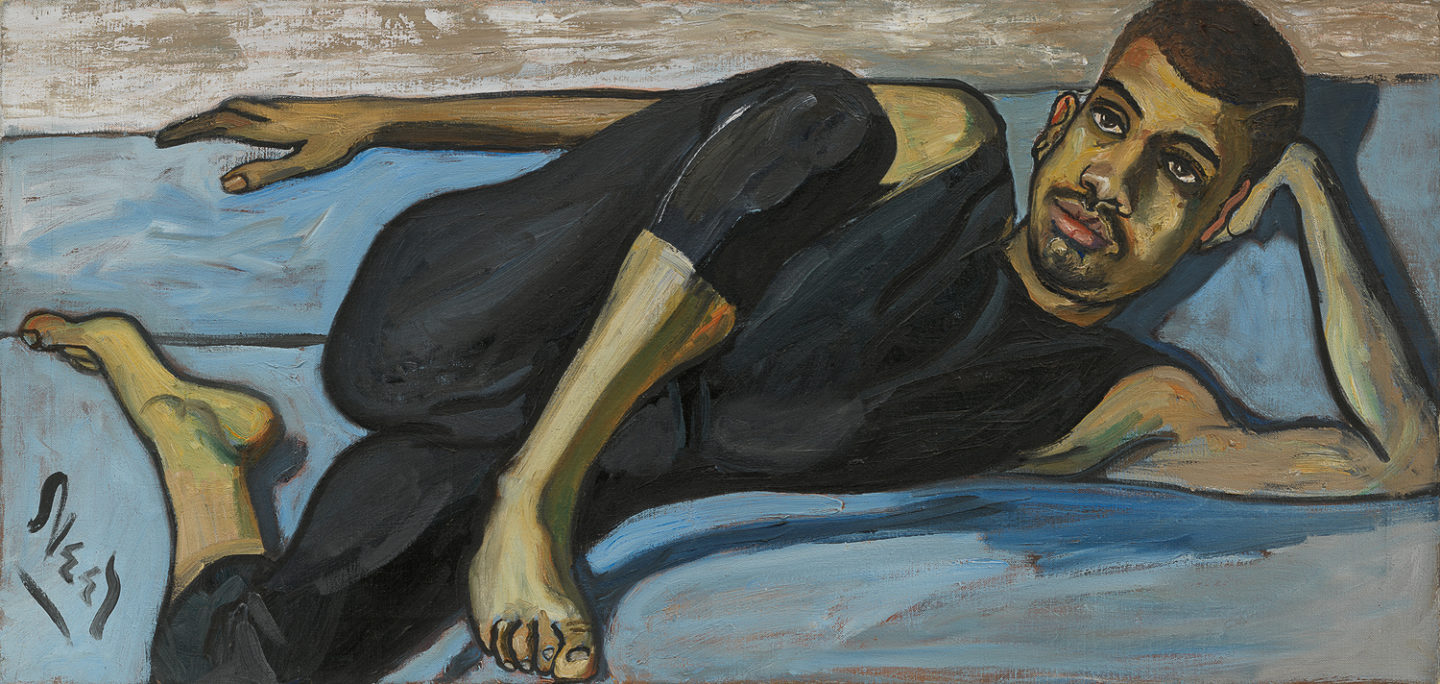
Oil on canvas
51.1 x 107 cm
20 1/8 x 42 1/8 inches
Alice Neel, Ballet Dancer, 1950
More infoThis painting depicts an unnamed young dancer reclining on a sofa. Writing in Frieze in 2017, Andrianna Campbell notes, ‘Many of Neel’s male sitters seem to exude a gay or queer subjectivity, [such as] the beautifully sprawling figure of Ballet Dancer (1950)…. With their distinctive painterly style, Neel’s portraits explore personalities, rather than physical types; they also memorialize figures historically excluded from the art world, which has long devalued depictions of people of color, advancing a more capacious vision of community.’
Martin Jay, 1932
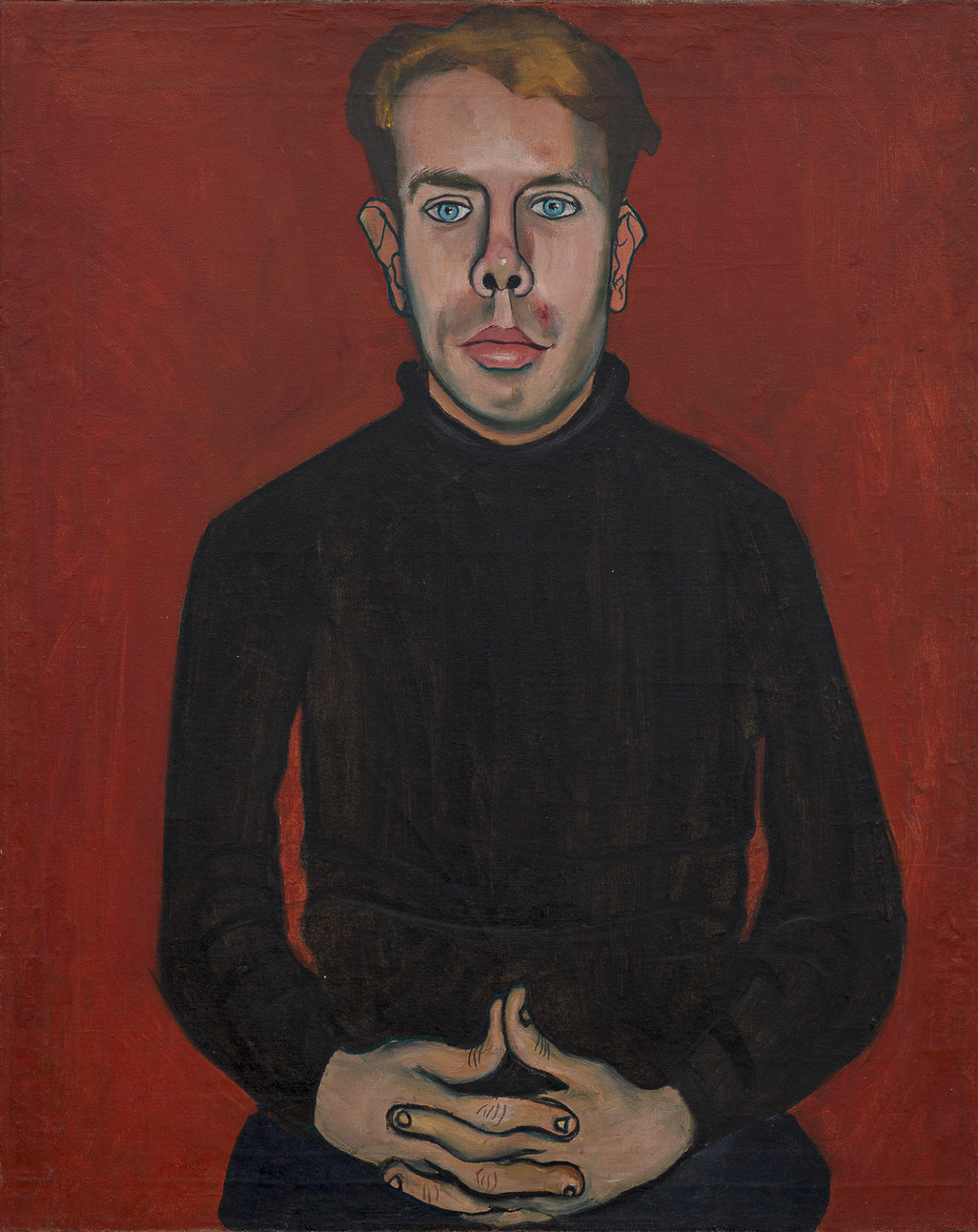
Oil on canvas
25 x 20 1/4in
63.5 x 51.4cm
Alice Neel, Martin Jay, 1932
More infoThe earliest work in this exhibition depicts James Leippert (1909–1964), an enigmatic young publisher of modern poetry who was an active member of the Communist party. He was known as Ronald Lane Latimer and often went by the pseudonym Martin Jay. At Columbia College in the early 1930s, he helped found the school’s literary magazines The Lion and Crown and The New Broom and Morningside, in which he published work by Erskine Caldwell and Gertrude Stein, among others. Neel paints him wearing a black turtleneck against a solid red background, his hands clasped and resting on his lap, exuding a quiet confidence.
Mary Garrard, 1977
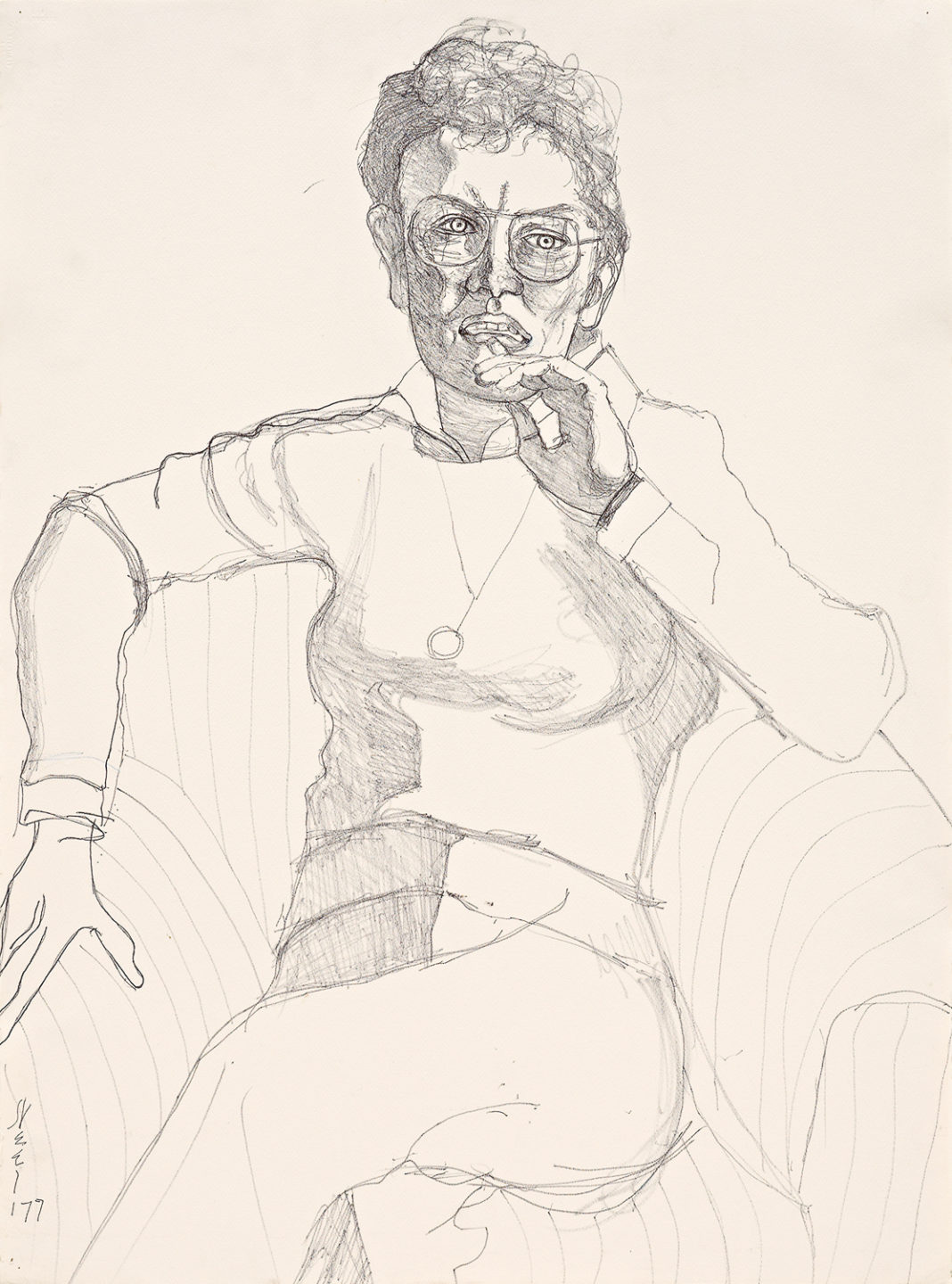
Ink and graphite on paper
30 1/8 x 22 1/2in
76.5 x 57.1cm
Alice Neel, Mary Garrard, 1977
More info‘In each of us, there are suppressed and minimized parts of our personalities that sometimes need expressing. In pulling those out of me, Alice did me a favor.’ — Mary Garrard
Mary Garrard (born 1937) is an esteemed art historian celebrated for her groundbreaking contributions to the field of feminist scholarship. She is known for her pioneering studies of the life and work of Baroque painter Artemisia Gentileschi and for coediting several books on feminism and art history that have become central texts in the discipline. Around the time of this drawing, Garrard sat on the board of advisors for the New York Feminist Art Institute and had just completed her term as the second president of the Women’s Caucus for Art. Neel also depicted Garrard in a painting completed the same year. Writing about her personal experience sitting for the artist, Garrard notes, ‘In confronting me with more of my identity than I wished at the time to share, she may have pushed me to be a bit more open, though at first it was by way of confronting her back. The portrait has a bit of that in it – a little, ‘‘how dare you?”… In each of us, there are suppressed and minimized parts of our personalities that sometimes need expressing. In pulling those out of me, Alice did me a favor.’
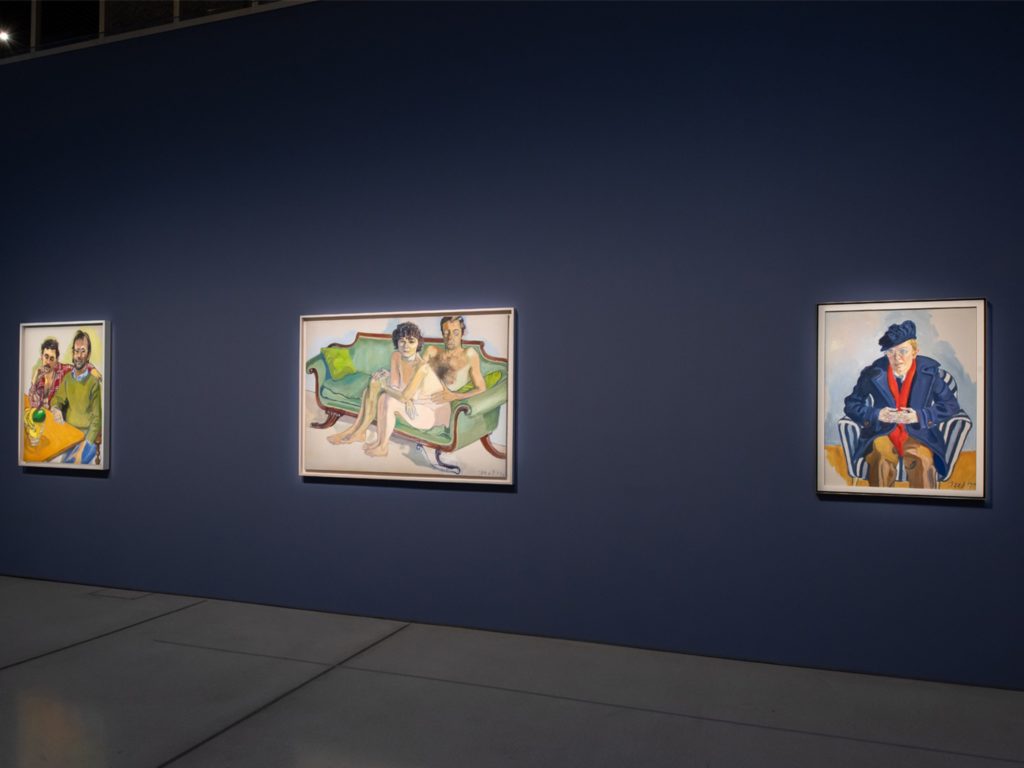
Adrienne Rich, 1973
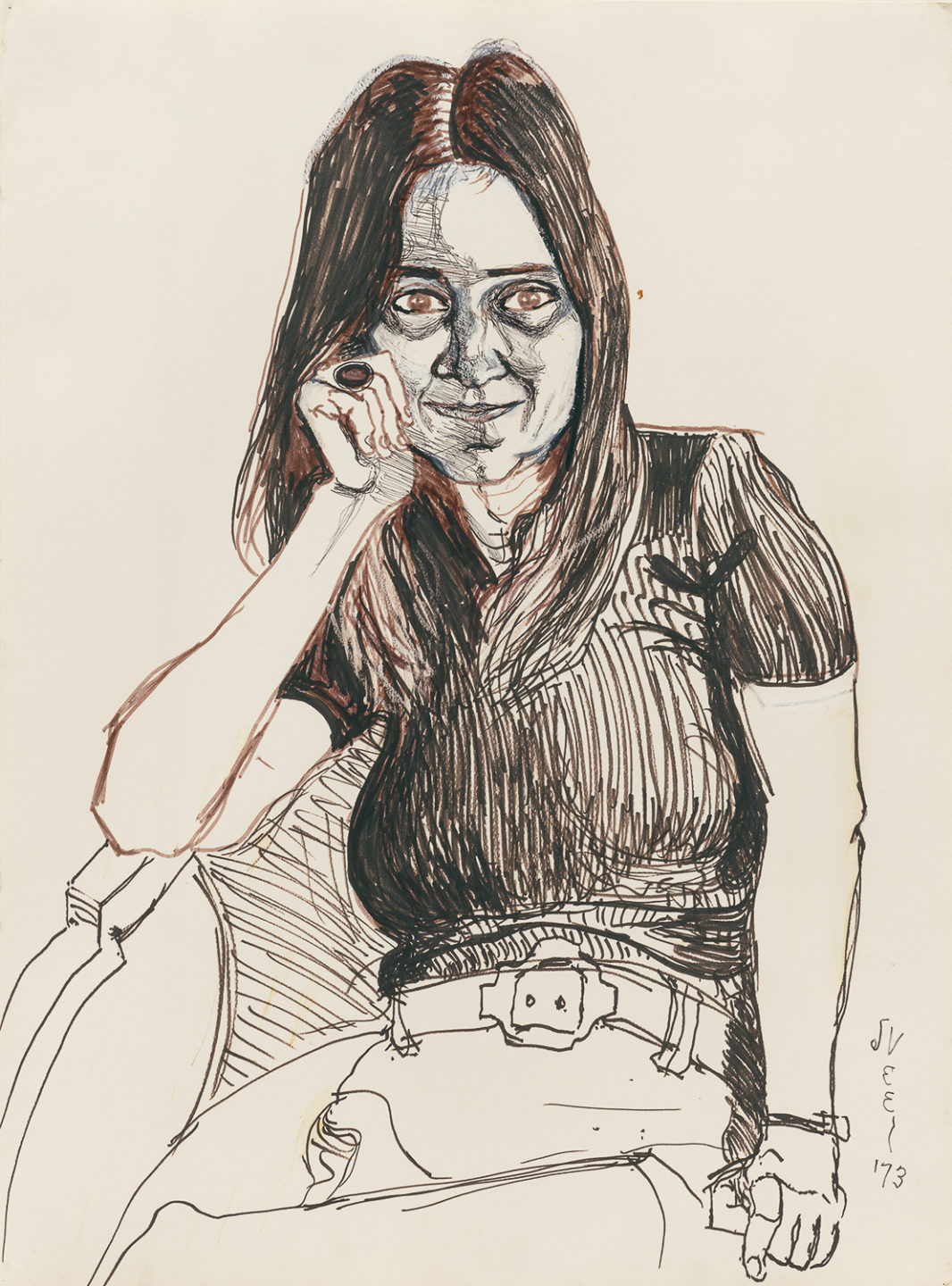
Ink on paper
75.6 x 55.9 cm
29 3/4 x 22 in
Alice Neel, Adrienne Rich, 1973
More infoAn American poet and feminist, Adrienne Rich (1929–2012) is often credited with bringing women’s and lesbian issues to the forefront of poetry. Rich is best known for her seminal 1980 essay Compulsory Heterosexuality and Lesbian Existence, in which she critiques the assumption that heterosexuality is the default or ‘natural’ sexual orientation for women. Rich argues that this assumption is socially constructed and perpetuated by patriarchal institutions, effectively marginalising and erasing lesbian existence and experiences and permanently rendering women in subordinate roles. The essay has had a profound impact on feminist theory, LGBTQ+ studies, and broader discourse on sexuality and gender. Rich remains one of the most respected American poets.
Drawing was a fundamental, stand-alone component of Neel’s practice. The medium enabled Neel to capture the immediacy of her visual experience – whether in front of her sitters or on the city streets – while also affording a greater sense of experimentation and informality.
Richard Gibbs, 1965
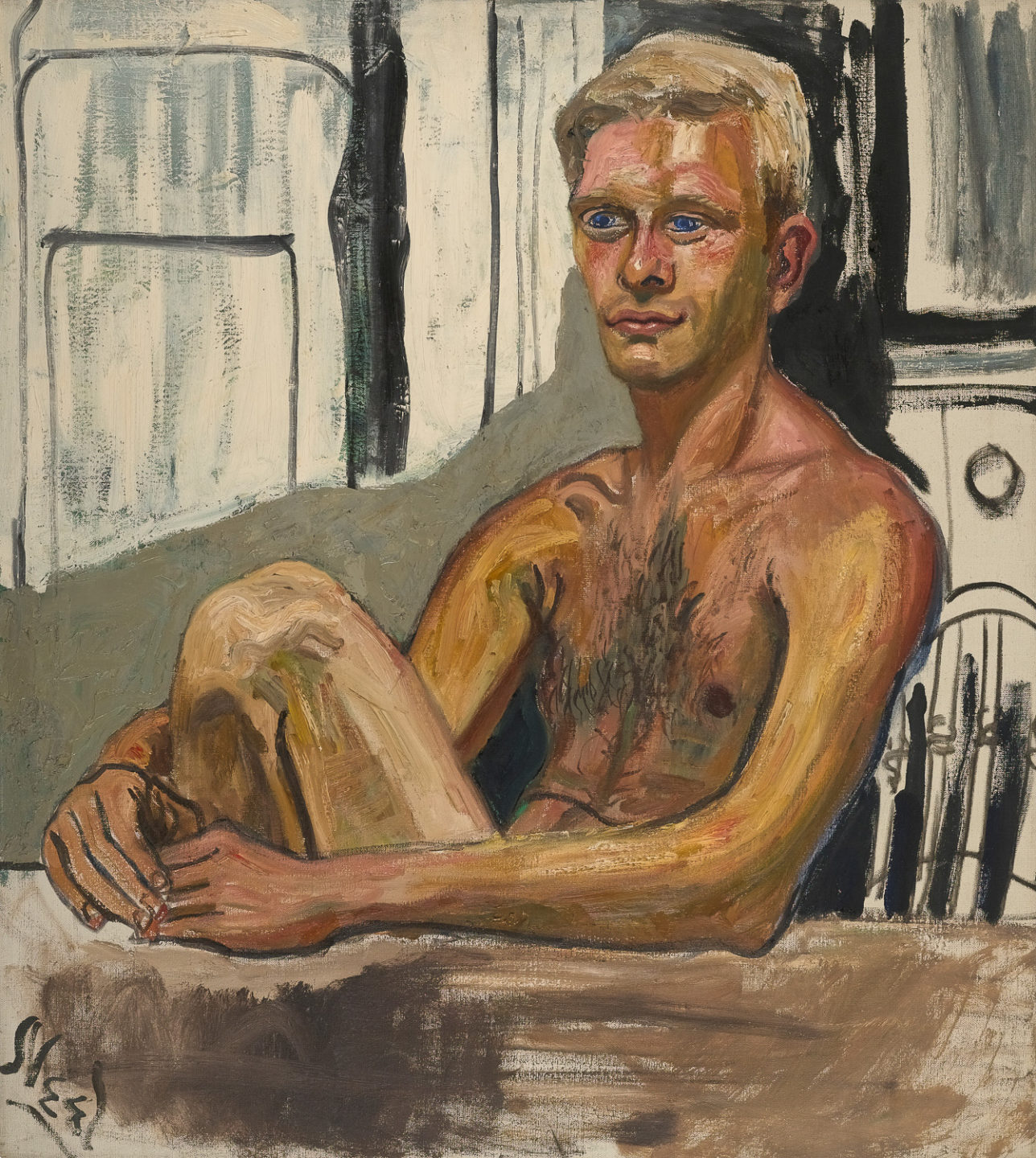
Oil on canvas
96.5 x 86.4 cm
38 x 34 in
Alice Neel, Richard Gibbs, 1965
More infoRichard Gibbs was a young artist and friend of Neel’s whom she painted on at least three occasions during the 1960s. Neel met and painted Gibbs in Spring Lake, New Jersey, where Neel had a cottage and spent summers with her family. Gibbs also made trips to visit Neel in New York. While Gibbs is painted shirtless, his bent knee raised above the table at which he sits, a painting of Gibbs’ unnamed friend (below) shows him seated with one hand on his hip and the other poised against his face, which wears an expression of earnest seriousness.
Richard Gibbs’ Friend, 1962
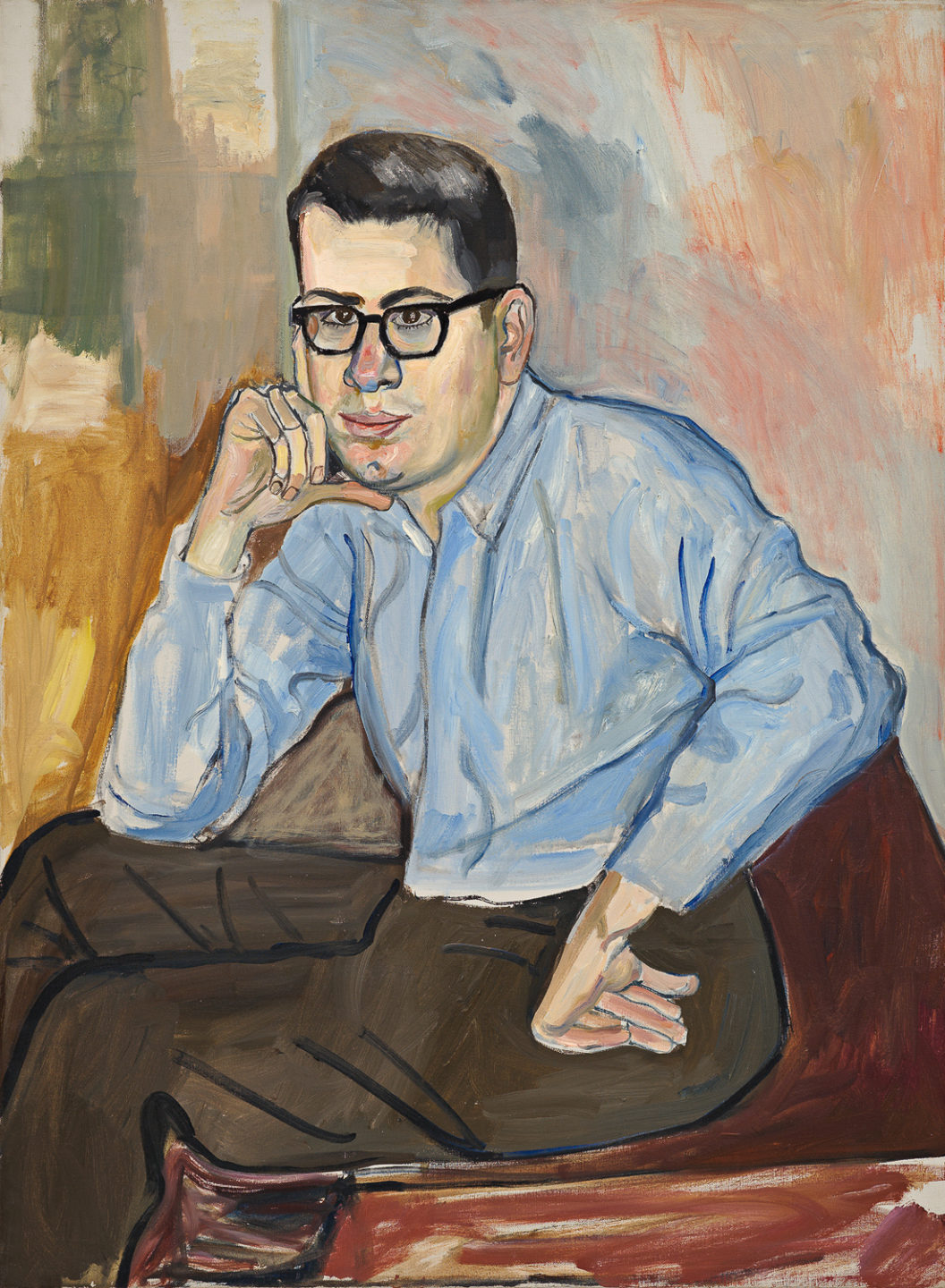
Oil on canvas
42 x 31in
106.7 x 78.7cm
Alice Neel, Richard Gibbs’ Friend, 1962
More infoDavid and Catherine Saalfield, 1982
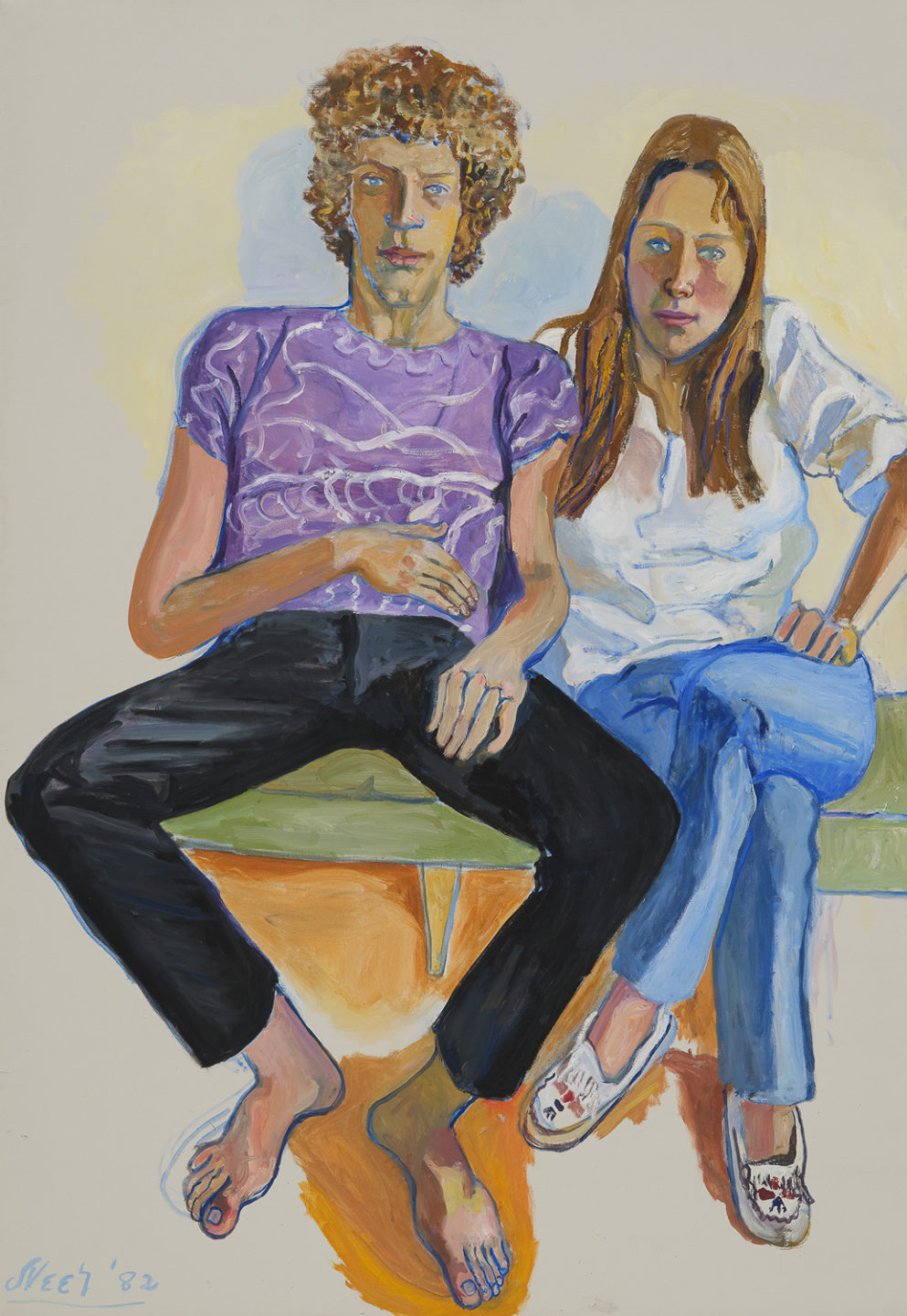
Oil on canvas
162.9 x 111.8 cm
64 1/8 x 44 in
Alice Neel, David and Catherine Saalfield, 1982
More infoPictured here as a teenager with her older brother, David, Catherine Gund (born Catherine Saalfield, 1965) is the daughter of philanthropist Agnes Gund and her first husband. Gund is a queer documentary filmmaker and a lifelong political activist, having cofounded, in 1989, the activist video collective DIVA TV (Damned Interfering Video Activists Television). DIVA TV was an affinity group of the New York chapter of ACT UP (Aids Coalition to Unleash Power), producing the films Target City Hall, Pride ’69–’89 (both 1989), and Like a Prayer: Stop the Church (1990). Around this time, Gund also directed several short works for the weekly public-access show Paper Tiger Television, and she produced the four-part PBS series Positive: Life with HIV in 1995. Together with organiser and scholar Scot Nakagawa, in 1996 Gund founded Aubin Pictures, where as founder and director she supports artists and filmmakers who share her focus on social, racial, and reproductive justice, HIV/AIDS awareness and activism, arts and culture, and the environment.
‘Sometimes in the silence of the paintings you wonder what was said during a Neel session, what language Alice used as she and her subject talked about the old times, the new times, and probably everything in between…’ — Hilton Als
Kris Kirsten, 1971
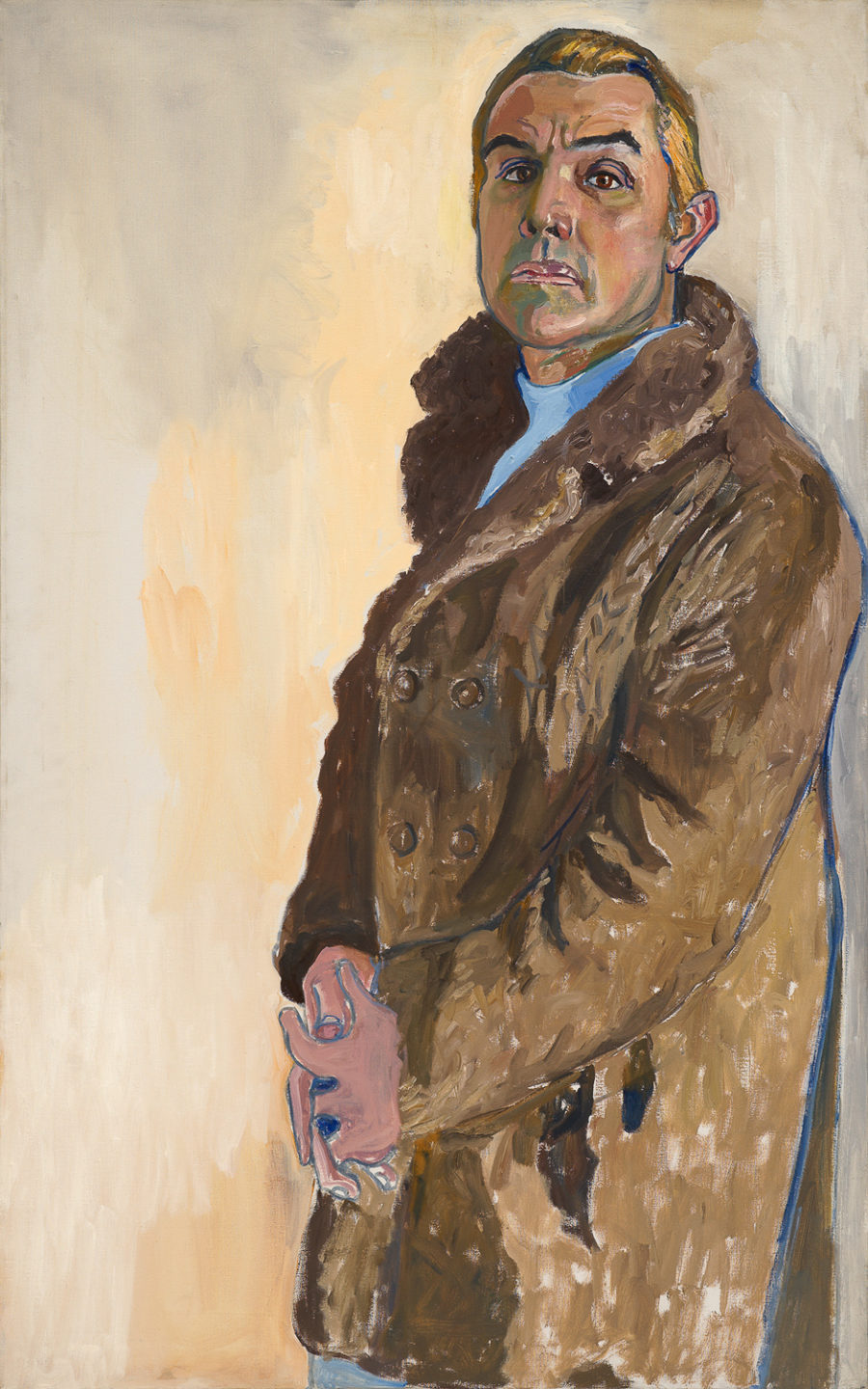
Oil on canvas
47 7/8 x 30in
121.6 x 76.2cm
Alice Neel, Kris Kirsten, 1971
More infoThis painting depicts Kris Kirsten, an acquaintance of Neel’s. Wearing a fur coat, his hands clasped together, Kirsten’s gaze meets ours; one eyebrow is raised as if in acknowledgement of the encounter. His pose, a three-quarter view that recalls historical portraiture, combined with Neel’s rendering of his coat reminds us of the myriad ways in which Neel captured aspects of character – of a person, place or time.
Paul Kuyer, 1959
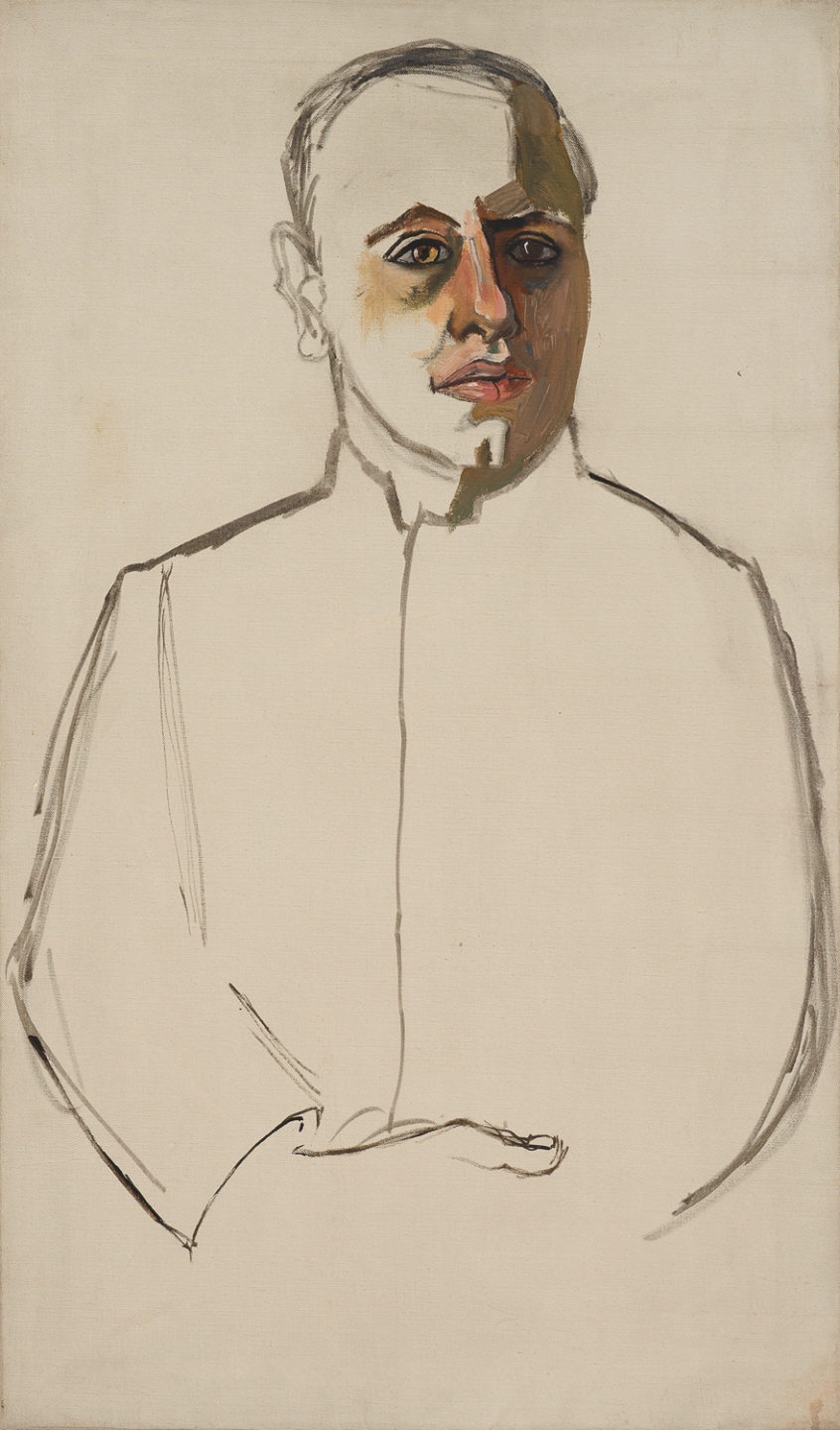
Oil on canvas
34 x 20 1/8in
86.4 x 51.1cm
Alice Neel, Paul Kuyer, 1959
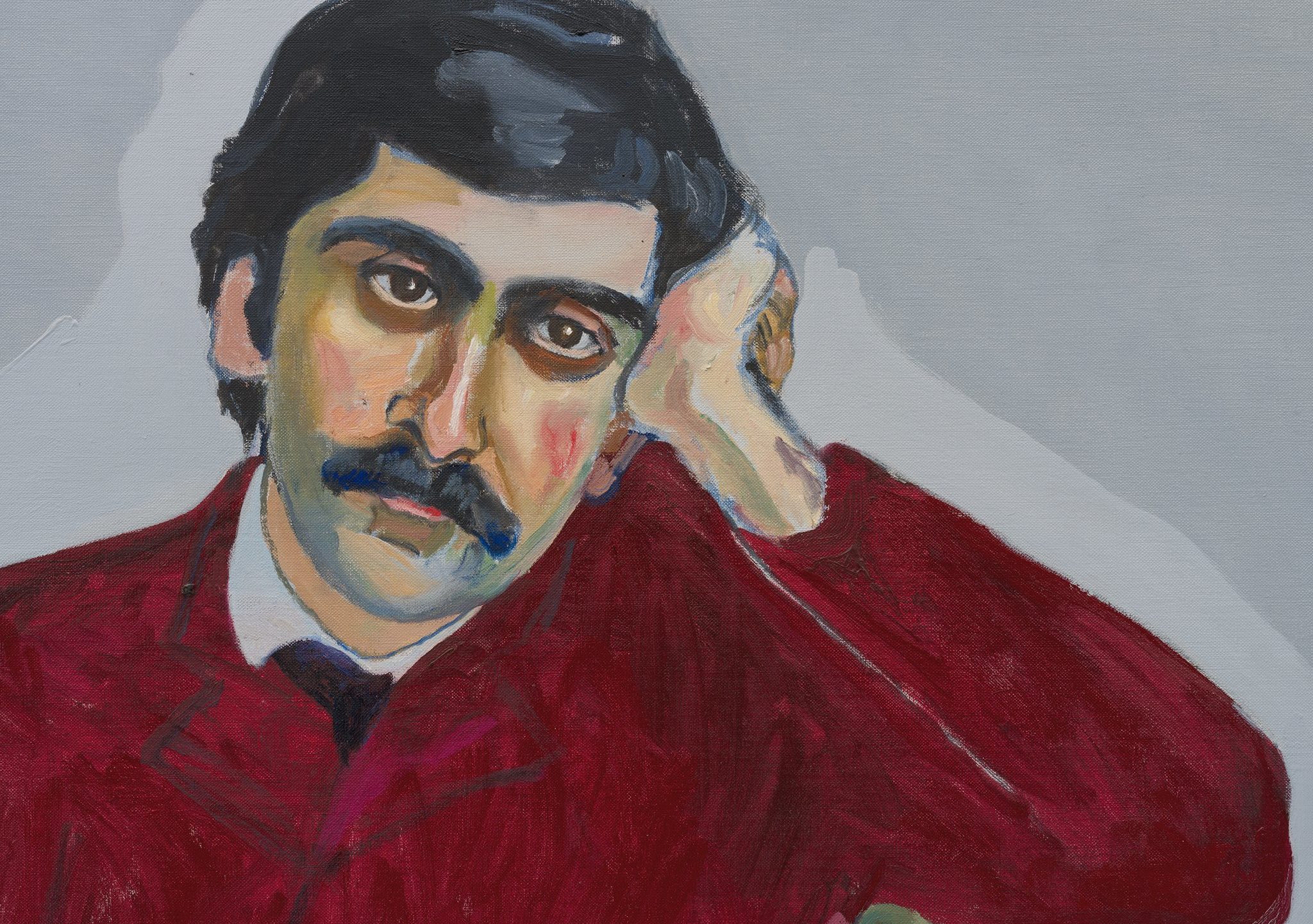
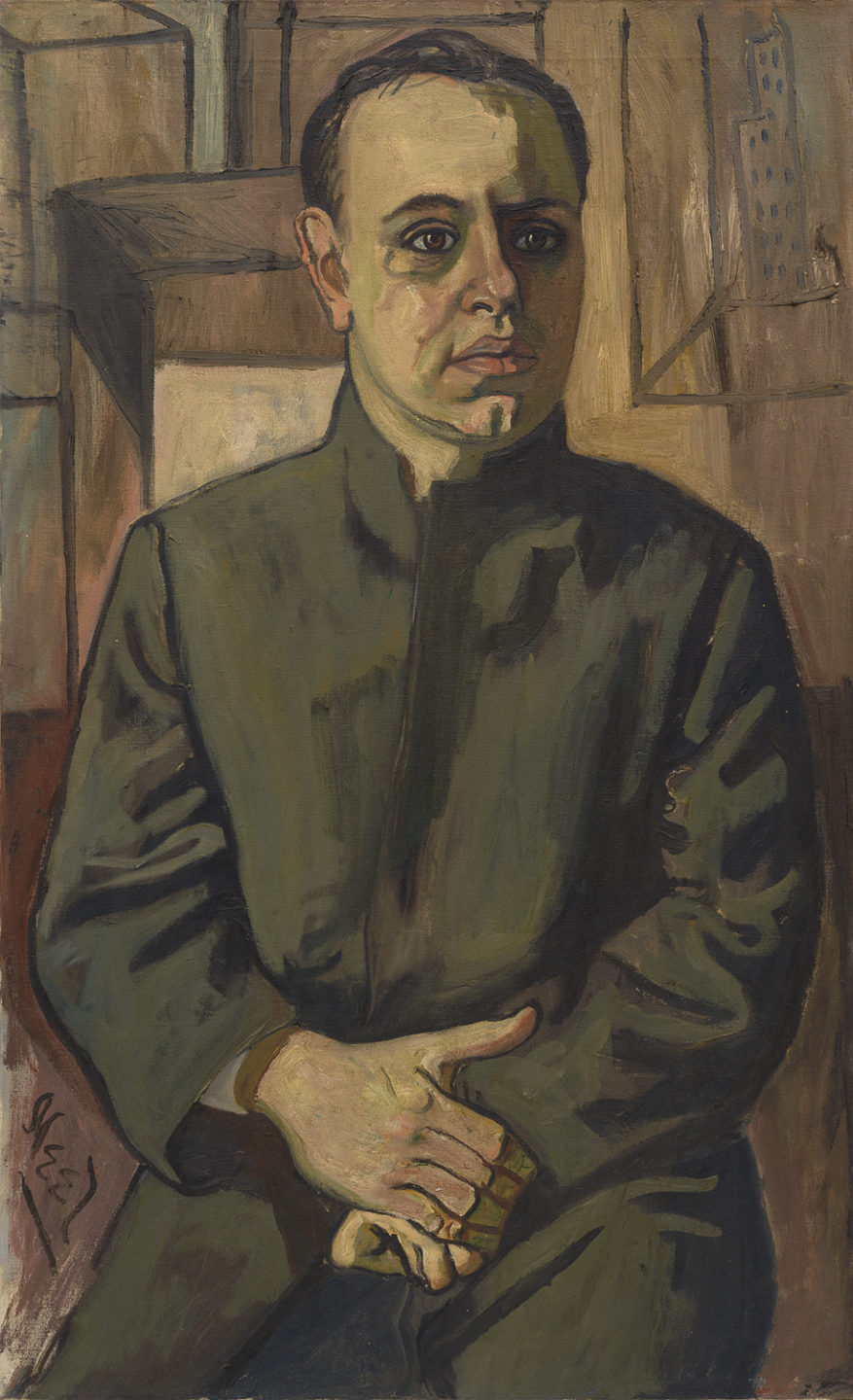
Oil on canvas
36 x 22in
91.4 x 55.9cm

Oil on canvas
36 x 22in
91.4 x 55.9cm
Alice Neel, Paul Kuyer, 1959
Paul Kuyer was a good friend of Neel’s whom she met through her longtime friend John Rothschild. At the time these works were completed, Kuyer was editor of The Civil Service Leader, a magazine for public employees. Neel recalled that he had considered becoming a priest and was a lover of opera; the duo attended the Metropolitan Opera together on at least one occasion. In 1959 Neel made two paintings of Kuyer, one more unfinished than most of her work, which highlights her economy of line, and a related, more fully composed work. Both portraits show Kuyer, his face serene, wearing a high-collared coat reminiscent of priestly garments.
Paul Kuyer was a good friend of Neel’s whom she met through her longtime friend John Rothschild. At the time these works were completed, Kuyer was editor of The Civil Service Leader, a magazine for public employees. Neel recalled that he had considered becoming a priest and was a lover of opera; the duo attended the Metropolitan Opera together on at least one occasion. In 1959 Neel made two paintings of Kuyer, one more unfinished than most of her work, which highlights her economy of line, and a related, more fully composed work. Both portraits show Kuyer, his face serene, wearing a high-collared coat reminiscent of priestly garments.
John Cheim, 1979
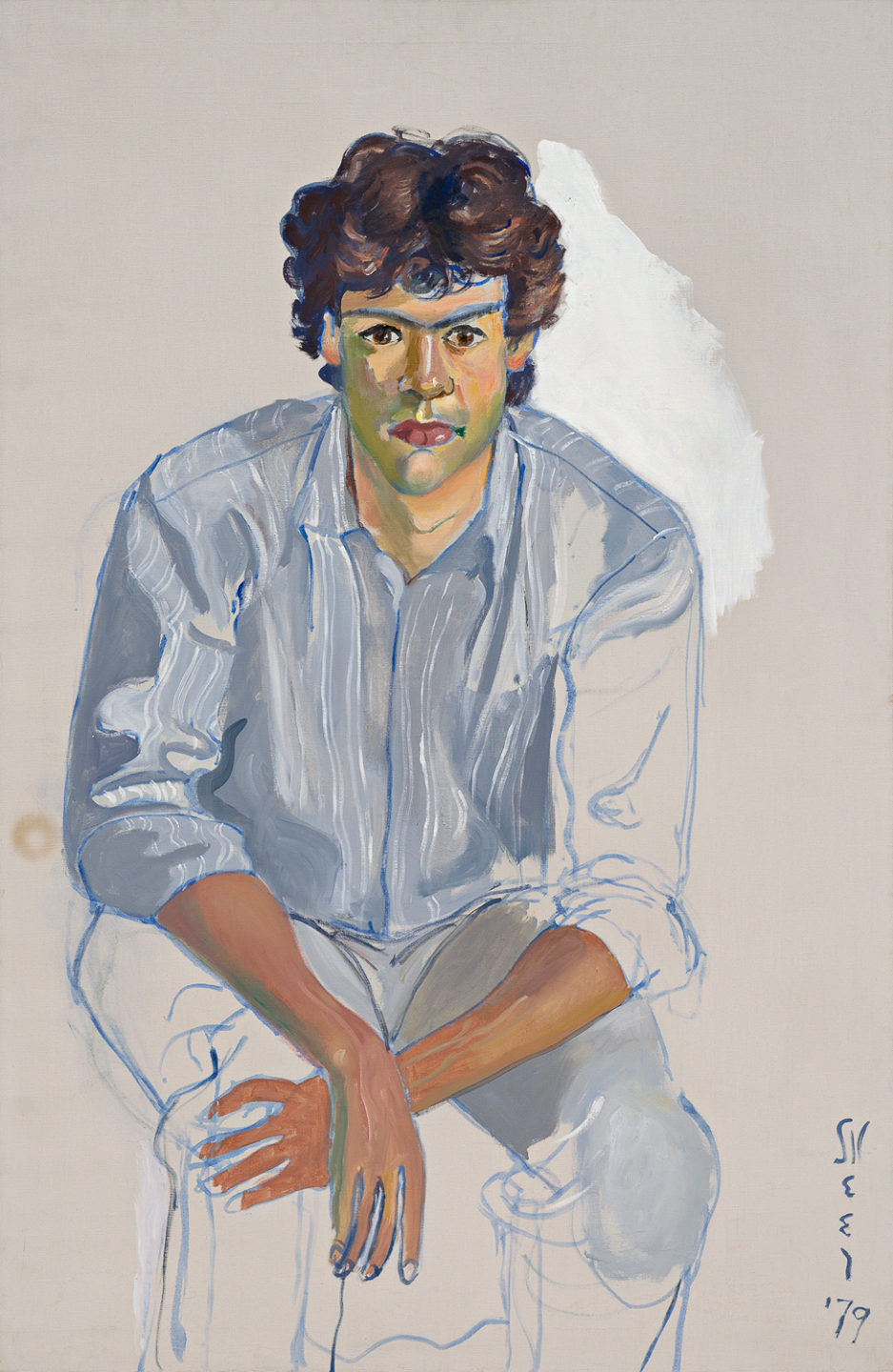
Oil on canvas
45 1/2 x 30 in
115.6 x 76.2 cm

Oil on canvas
45 1/2 x 30 in
115.6 x 76.2 cm
Alice Neel, John Cheim, 1979
A longtime art dealer and gallerist, John Cheim (b.1950s) cofounded the gallery Cheim & Reid in New York in 1997. He moved to the city after graduating from Rhode Island School of Design in 1977 and began working at Robert Miller Gallery, which represented Neel at the end of her career. In 1985, Cheim organised and curated the solo exhibition Alice Neel: Paintings since 1970 at Pennsylvania Academy of the Fine Arts, Philadelphia. Cheim is a celebrated book designer and has designed publications for prominent artists including Jean-Michel Basquiat, Robert Mapplethorpe and Andy Warhol.
A longtime art dealer and gallerist, John Cheim (b.1950s) cofounded the gallery Cheim & Reid in New York in 1997. He moved to the city after graduating from Rhode Island School of Design in 1977 and began working at Robert Miller Gallery, which represented Neel at the end of her career. In 1985, Cheim organised and curated the solo exhibition Alice Neel: Paintings since 1970 at Pennsylvania Academy of the Fine Arts, Philadelphia. Cheim is a celebrated book designer and has designed publications for prominent artists including Jean-Michel Basquiat, Robert Mapplethorpe and Andy Warhol.
Publication
Alice Neel’s unstinting, visionary engagement with the lives of those around her resulted in an inclusive oeuvre. The aspect of queer representation in her work is explored for the first time in this new catalogue, published by David Zwirner Books.
Edited and with a text by Hilton Als, the volume includes newly commissioned contributions by Alex Fialho, Evan Garza, and Wayne Koestenbaum.
Alice Neel’s unstinting, visionary engagement with the lives of those around her resulted in an inclusive oeuvre. The aspect of queer representation in her work is explored for the first time in this new catalogue, published by David Zwirner Books.
Edited and with a text by Hilton Als, the volume includes newly commissioned contributions by Alex Fialho, Evan Garza, and Wayne Koestenbaum.
About Alice Neel
Alice Neel was born near Philadelphia, Pennsylvania in 1900 and died in 1984 in New York. Recent institutional exhibitions include Alice Neel: Feels Like Home, Orange County Museum of Art, California, USA (2023–2024); the major retrospective, Alice Neel: Un regard engagé, highlighting the political and social commitment of the painter, at the Centre Pompidou, Paris, France (2022–2023), which travelled to the Barbican Centre in London, UK (Alice Neel: Hot Off The Griddle, 2023) and to MUNCH, Oslo, Norway (Alice Neel: Every Person is a New Universe, 2023); and the acclaimed 2021–2022 touring survey Alice Neel: People Come First, organised by The Metropolitan Museum of Art, New York, USA, in association with the Guggenheim Museum Bilbao, Spain, and The Fine Arts Museums of San Francisco, USA.
Previous solo institutional exhibitions include Alice Neel: Painter of Modern Life at Ateneum Art Museum, Helsinki, Finland (2016) travelling to Gemeentemuseum, The Hague, Netherlands (2016–2017), Fondation Vincent van Gogh, Arles, France (2017), Deichtorhallen, Hamburg, Germany (2017–2018); Alice Neel: The Subject and Me, Talbot Rice Gallery, The University of Edinburgh, UK (2016); Alice Neel: Intimate Relations, Nordiska Akvarellmuseet, Skarhamn, Sweden (2013); Alice Neel: Painted Truths, a retrospective that toured to the Museum of Fine Arts Houston, USA (2010), the Whitechapel Art Gallery, London, UK (2010) and the Moderna Museet, Malmö, Sweden (2010–11); Collector of Souls at the Moderna Museet, Stockholm, Sweden (2008) and Alice Neel, organised by the Philadelphia Museum of Art, USA and travelling to the Whitney Museum of American Art, New York, USA (2000).
Neel’s work is in the collections of major museums including the Metropolitan Museum of Art, New York, USA; Tate, London, UK; the Art Institute of Chicago, USA; the Brooklyn Museum of Art, New York, USA; the Denver Art Museum, USA; the Milwaukee Art Museum, USA; the Moderna Museet, Stockholm, Sweden; the Museum of Contemporary Art, Los Angeles, USA; Los Angeles County Museum of Art, USA; the Museum of Fine Arts, Boston, USA; the Museum of Fine Arts, Houston, USA; the Museum of Modern Art, New York, USA; the Philadelphia Museum of Art, USA and Whitney Museum of American Art, New York, USA.
Alice Neel was born near Philadelphia, Pennsylvania in 1900 and died in 1984 in New York. Recent institutional exhibitions include Alice Neel: Feels Like Home, Orange County Museum of Art, California, USA (2023–2024); the major retrospective, Alice Neel: Un regard engagé, highlighting the political and social commitment of the painter, at the Centre Pompidou, Paris, France (2022–2023), which travelled to the Barbican Centre in London, UK (Alice Neel: Hot Off The Griddle, 2023) and to MUNCH, Oslo, Norway (Alice Neel: Every Person is a New Universe, 2023); and the acclaimed 2021–2022 touring survey Alice Neel: People Come First, organised by The Metropolitan Museum of Art, New York, USA, in association with the Guggenheim Museum Bilbao, Spain, and The Fine Arts Museums of San Francisco, USA.
Previous solo institutional exhibitions include Alice Neel: Painter of Modern Life at Ateneum Art Museum, Helsinki, Finland (2016) travelling to Gemeentemuseum, The Hague, Netherlands (2016–2017), Fondation Vincent van Gogh, Arles, France (2017), Deichtorhallen, Hamburg, Germany (2017–2018); Alice Neel: The Subject and Me, Talbot Rice Gallery, The University of Edinburgh, UK (2016); Alice Neel: Intimate Relations, Nordiska Akvarellmuseet, Skarhamn, Sweden (2013); Alice Neel: Painted Truths, a retrospective that toured to the Museum of Fine Arts Houston, USA (2010), the Whitechapel Art Gallery, London, UK (2010) and the Moderna Museet, Malmö, Sweden (2010–11); Collector of Souls at the Moderna Museet, Stockholm, Sweden (2008) and Alice Neel, organised by the Philadelphia Museum of Art, USA and travelling to the Whitney Museum of American Art, New York, USA (2000).
Neel’s work is in the collections of major museums including the Metropolitan Museum of Art, New York, USA; Tate, London, UK; the Art Institute of Chicago, USA; the Brooklyn Museum of Art, New York, USA; the Denver Art Museum, USA; the Milwaukee Art Museum, USA; the Moderna Museet, Stockholm, Sweden; the Museum of Contemporary Art, Los Angeles, USA; Los Angeles County Museum of Art, USA; the Museum of Fine Arts, Boston, USA; the Museum of Fine Arts, Houston, USA; the Museum of Modern Art, New York, USA; the Philadelphia Museum of Art, USA and Whitney Museum of American Art, New York, USA.
About Hilton Als
Hilton Als is an award-winning journalist, critic and curator. He has been a staff writer at The New Yorker since 1994. Prior to The New Yorker, Als was a staff writer for The Village Voice and an editor-at-large at Vibe. He has received numerous awards for his work, including the Pulitzer Prize for Criticism (2017), Yale’s Windham-Campbell Literature Prize (2016), the George Jean Nathan Award for Dramatic Criticism (2002–03), and a Guggenheim Fellowship (2000). His first book, The Women, was published in 1996. His next book, White Girls, was a finalist for the National Book Critics Circle Award and the winner of the Lambda Literary Award in 2014. His most recent book, My Pinup, was published in November 2022. In 2017, he curated the critically lauded exhibition Alice Neel, Uptown, which travelled from David Zwirner, New York, USA to Victoria Miro, London, UK and Venice, Italy. In 2019, Als presented God Made My Face: A Collective Portrait of James Baldwin at David Zwirner, New York, USA, followed by Frank Moore at, David Zwirner, New York, USA (2021) and Toni Morrison’s Black Book, at David Zwirner, New York, USA (2022). He curated a series of three successive exhibitions for the Yale Center for British Art, New Haven, Connecticut, USA, of the work of Celia Paul (2018), Lynette Yiadom-Boakye (2019), and Njideka Akunyili Crosby (2022). In 2022, he curated Joan Didion: What She Means at the Hammer Museum, Los Angeles, USA, which travelled to the Pérez Art Museum Miami, USA in 2023–2024. He is currently a teaching professor at the University of California, Berkeley, and has also tau
Hilton Als is an award-winning journalist, critic and curator. He has been a staff writer at The New Yorker since 1994. Prior to The New Yorker, Als was a staff writer for The Village Voice and an editor-at-large at Vibe. He has received numerous awards for his work, including the Pulitzer Prize for Criticism (2017), Yale’s Windham-Campbell Literature Prize (2016), the George Jean Nathan Award for Dramatic Criticism (2002–03), and a Guggenheim Fellowship (2000). His first book, The Women, was published in 1996. His next book, White Girls, was a finalist for the National Book Critics Circle Award and the winner of the Lambda Literary Award in 2014. His most recent book, My Pinup, was published in November 2022. In 2017, he curated the critically lauded exhibition Alice Neel, Uptown, which travelled from David Zwirner, New York, USA to Victoria Miro, London, UK and Venice, Italy. In 2019, Als presented God Made My Face: A Collective Portrait of James Baldwin at David Zwirner, New York, USA, followed by Frank Moore at, David Zwirner, New York, USA (2021) and Toni Morrison’s Black Book, at David Zwirner, New York, USA (2022). He curated a series of three successive exhibitions for the Yale Center for British Art, New Haven, Connecticut, USA, of the work of Celia Paul (2018), Lynette Yiadom-Boakye (2019), and Njideka Akunyili Crosby (2022). In 2022, he curated Joan Didion: What She Means at the Hammer Museum, Los Angeles, USA, which travelled to the Pérez Art Museum Miami, USA in 2023–2024. He is currently a teaching professor at the University of California, Berkeley, and has also tau
